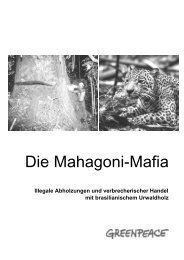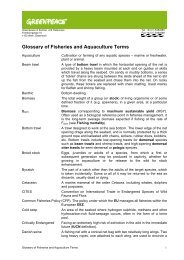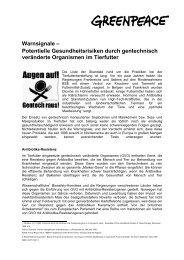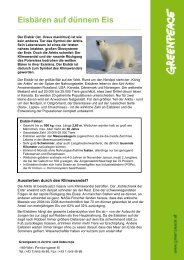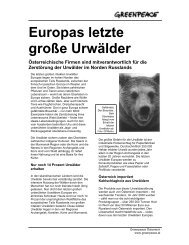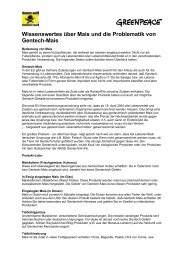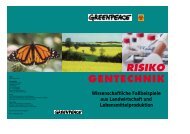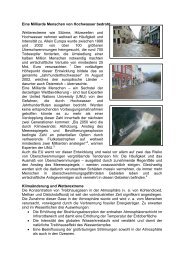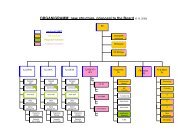POISON UNDERFOOT Hazardous Chemicals in PVC Flooring and ...
POISON UNDERFOOT Hazardous Chemicals in PVC Flooring and ...
POISON UNDERFOOT Hazardous Chemicals in PVC Flooring and ...
Create successful ePaper yourself
Turn your PDF publications into a flip-book with our unique Google optimized e-Paper software.
<strong>POISON</strong> <strong>UNDERFOOT</strong><br />
<strong>Hazardous</strong> <strong>Chemicals</strong> <strong>in</strong> <strong>PVC</strong> Floor<strong>in</strong>g<br />
<strong>and</strong><br />
<strong>Hazardous</strong> <strong>Chemicals</strong> <strong>in</strong> Carpets<br />
Two reports compiled for the Healthy Floor<strong>in</strong>g Network by<br />
Michelle Allsopp, David Santillo <strong>and</strong> Paul Johnston,<br />
Greenpeace Research Laboratories,<br />
University of Exeter<br />
EX4 4PS
EXECUTIVE SUMMARY<br />
This study was undertaken to identify <strong>and</strong> quantify the levels of certa<strong>in</strong> chemical additives <strong>in</strong><br />
fitted carpet <strong>and</strong> <strong>PVC</strong> floor<strong>in</strong>g. Eight br<strong>and</strong>s of carpet <strong>and</strong> five br<strong>and</strong>s of <strong>PVC</strong> floor<strong>in</strong>g that<br />
were available for retail <strong>in</strong> the UK were studied 1 . Both the <strong>PVC</strong> floor<strong>in</strong>g <strong>and</strong> carpet were<br />
analysed for certa<strong>in</strong> organot<strong>in</strong>s <strong>and</strong> phthalate plasticisers. In addition, the carpets were analysed<br />
for the pesticide permethr<strong>in</strong>, brom<strong>in</strong>ated flame retardants, formaldehyde <strong>and</strong> triclosan (an antimicrobial<br />
chemical). These chemicals were selected for study because of their hazardous<br />
properties, comb<strong>in</strong>ed with the knowledge that they are used <strong>in</strong> some consumer products.<br />
The <strong>in</strong>tention of the study was solely to provide empirical data on the chemical composition of<br />
carpets <strong>and</strong> <strong>PVC</strong> floor<strong>in</strong>g. It was not <strong>in</strong>tended to generate data for calculat<strong>in</strong>g potential leach<strong>in</strong>g<br />
rates from floor<strong>in</strong>g of for calculat<strong>in</strong>g potential doses that <strong>in</strong>dividuals may take from exposure to<br />
such floor<strong>in</strong>g <strong>in</strong> the home <strong>and</strong> potential consequences for human health.<br />
The <strong>PVC</strong> floor<strong>in</strong>g samples were found to conta<strong>in</strong> high levels of several organot<strong>in</strong> compounds,<br />
<strong>in</strong> particular dibutylt<strong>in</strong> (DBT, 37.7 - 569 ppm), <strong>and</strong> tributylt<strong>in</strong> (TBT, 128 - 17,940 ppb). These<br />
compounds are known to be used as stabilisers <strong>in</strong> some <strong>PVC</strong> products. Two of the eight carpet<br />
samples were also found to conta<strong>in</strong> substantial levels of TBT (2700 - 47500 ppb). It is notable<br />
that these carpet samples were registered as be<strong>in</strong>g treated with “Ultrafresh” for protection<br />
aga<strong>in</strong>st dust mites, bacteria, moulds <strong>and</strong> fungi. It is possible, though not certa<strong>in</strong>, that this biocide<br />
<strong>in</strong>corporated organot<strong>in</strong>s as active agents.<br />
The presence of high levels of organot<strong>in</strong>s <strong>in</strong> <strong>PVC</strong> floor<strong>in</strong>g <strong>and</strong> carpets is of particular concern<br />
s<strong>in</strong>ce they are persistent <strong>and</strong> are toxic to the immune system. As a consequence of the use of<br />
TBT <strong>in</strong> anti-foul<strong>in</strong>g pa<strong>in</strong>ts on ships hulls, this chemical has been responsible for major<br />
reproductive problems <strong>in</strong> some species of shellfish <strong>and</strong> <strong>in</strong> some <strong>in</strong>stances has been l<strong>in</strong>ked to<br />
massive population decl<strong>in</strong>es of these organisms. Recently, concern regard<strong>in</strong>g commercial uses<br />
of organot<strong>in</strong>s has led to a German proposal to ban the use of these chemicals <strong>in</strong> pa<strong>in</strong>ts for<br />
shipp<strong>in</strong>g, biocides <strong>in</strong> textiles <strong>and</strong> other uses from the end of 2002.<br />
High concentrations of certa<strong>in</strong> phthalate plasticisers were found <strong>in</strong> the <strong>PVC</strong> floor<strong>in</strong>g samples. In<br />
the carpet samples, phthalates were not found above the limit of detection. Phthalates are added<br />
to <strong>PVC</strong> to make it flexible. Diisononyl phthalate (DINP) was found <strong>in</strong> all the <strong>PVC</strong> floor<strong>in</strong>g<br />
samples at levels rang<strong>in</strong>g from 4.7 to 15.8% by weight <strong>and</strong> butyl benzyl phthalate (BBP) was<br />
present <strong>in</strong> three samples at levels between 1.6 to 5.0%. The presence <strong>and</strong> quantity of DINP <strong>and</strong><br />
BBP <strong>in</strong> <strong>PVC</strong> floor<strong>in</strong>g is of concern given the potential for human exposure <strong>in</strong> the <strong>in</strong>door<br />
environment <strong>and</strong> their potential toxicity.<br />
Phthalates cause a wide range of toxic effects <strong>in</strong> laboratory animals. In particular, BBP has been<br />
shown to have teratogenic (birth defects), reproductive <strong>and</strong> developmental effects as well as<br />
endocr<strong>in</strong>e-disrupt<strong>in</strong>g effects (that is, it <strong>in</strong>terferes with the body’s hormonal system). Due to its<br />
high toxicity the presence of BBP <strong>in</strong> <strong>PVC</strong> floor<strong>in</strong>g was surpris<strong>in</strong>g. Previous research has shown<br />
that phthalates leach from <strong>PVC</strong> floor<strong>in</strong>g <strong>and</strong> are consequently found <strong>in</strong> dust particles <strong>in</strong> the<br />
home <strong>and</strong> <strong>in</strong> wash water from <strong>PVC</strong> floors. Young children may be subjected to the highest<br />
exposure to phthalates from <strong>PVC</strong> floors because their breath<strong>in</strong>g zone is closer to the floor <strong>and</strong><br />
1 The samples of carpet were manufactured by Br<strong>in</strong>tons Ltd, Rid<strong>in</strong>g Hall Carpets, Whitestone Weavers Ltd,<br />
Rawson Carpets, K<strong>in</strong>gsmead Carpets, Westex <strong>and</strong> B & Q carpet tiles. The samples of <strong>PVC</strong> floor<strong>in</strong>g were<br />
manufactured by Gerflor, Armstrong, Forbo Nairn, Marley Floors <strong>and</strong> B & Q.<br />
2
they have a larger volume of respiration than adults per kilo bodyweight. The health of young<br />
children is of particular concern with regard to phthalates <strong>in</strong> <strong>PVC</strong> floors. A study <strong>in</strong> Norway<br />
found that children liv<strong>in</strong>g <strong>in</strong> homes with <strong>PVC</strong> floors had a higher <strong>in</strong>cidence of bronchial<br />
obstruction than children liv<strong>in</strong>g <strong>in</strong> homes with wooden floors It was suggested that this may<br />
have been due to exposure to plasticisers <strong>in</strong> the <strong>PVC</strong>.<br />
Three of the eight carpet samples were found to conta<strong>in</strong> significant levels of permethr<strong>in</strong> (up to<br />
78 ppb), a pesticide used aga<strong>in</strong>st dust mites. Permethr<strong>in</strong> has been reported to have effects on the<br />
nervous system (neurotoxic) <strong>in</strong> laboratory animals. Previous research <strong>in</strong> Germany has<br />
demonstrated that elevated concentrations of permethr<strong>in</strong> found <strong>in</strong> domestic homes were largely<br />
due to the presence of treated carpets. The presence of permethr<strong>in</strong> <strong>in</strong> carpets analysed <strong>in</strong> the<br />
present study is of concern given the potential human exposure <strong>in</strong> the home via its migration to<br />
air <strong>and</strong> dusts. It is of note that a previous study reported that typical permethr<strong>in</strong> treatment of<br />
carpets, where permethr<strong>in</strong> penetrates the carpet fibres, was not effective <strong>in</strong> prevent<strong>in</strong>g habitation<br />
by dust mites.<br />
One of the eight carpet samples conta<strong>in</strong>ed significant levels (1600 ppb) of<br />
2,2’,3,3’,4,4’,5,5’,6,6’-decabromodiphenyl ether (BDE-209), a brom<strong>in</strong>ated flame retardant<br />
chemical. This is of concern given the persistent <strong>and</strong> toxic nature of this compound. While fire<br />
safety is an issue which cannot be compromised, it can be achieved through the use other less<br />
hazardous fire retardants or through redesign <strong>and</strong>/or reformulation of materials to achieve lower<br />
flammability. Five of the carpet samples were also found to conta<strong>in</strong> formaldehyde at low ppm<br />
concentrations.<br />
In conclusion, several hazardous chemicals were found <strong>in</strong> significant concentrations <strong>in</strong> new<br />
<strong>PVC</strong> floor<strong>in</strong>g <strong>and</strong> carpets. This highlights the cont<strong>in</strong>ued widespread use of hazardous chemicals<br />
<strong>in</strong> consumer products, uses for which most of the public will be unaware. The presence <strong>and</strong> the<br />
high concentrations of some of the chemicals <strong>in</strong> <strong>PVC</strong> floors <strong>and</strong> carpets was unexpected given<br />
that they are recognised as hazardous chemicals at both national <strong>and</strong> <strong>in</strong>ternational levels <strong>and</strong>, <strong>in</strong><br />
some cases, plans exist to reduce their use or phase them out.<br />
The results of this study are of concern as the presence of hazardous chemicals <strong>in</strong> <strong>PVC</strong> floor<strong>in</strong>g<br />
<strong>and</strong> carpets <strong>in</strong>evitably leads to human exposure <strong>in</strong> the <strong>in</strong>door environment. Floor<strong>in</strong>g makes up a<br />
substantial surface area with<strong>in</strong> the home; <strong>in</strong> particular, young children who breathe <strong>and</strong> play<br />
close to the floor are more likely to be exposed to hazardous chemicals <strong>in</strong> both <strong>PVC</strong> floor<strong>in</strong>g<br />
<strong>and</strong> fitted carpet. Although the consequences of long-term exposure to these chemicals <strong>in</strong> the<br />
<strong>in</strong>door environment is uncerta<strong>in</strong>, the chemicals have properties which make them potentially<br />
hazardous to human health <strong>and</strong> the environment. The identification of hazardous chemicals <strong>in</strong><br />
<strong>PVC</strong> floor<strong>in</strong>g <strong>and</strong> carpets by this study has revealed an important product sector which will<br />
need attention to prevent human exposure to such chemicals <strong>and</strong> possible health consequences.<br />
The data for the above study has been published as two <strong>in</strong>dividual technical notes, one on <strong>PVC</strong><br />
floor<strong>in</strong>g <strong>and</strong> the other on carpets. The former has already been submitted to the European<br />
Commission’s public consultation on Environmental Issues of <strong>PVC</strong>, <strong>in</strong> November 2000.<br />
3
<strong>Hazardous</strong> <strong>Chemicals</strong> <strong>in</strong> <strong>PVC</strong> Floor<strong>in</strong>g<br />
A report compiled for the Healthy Floor<strong>in</strong>g Network by<br />
Michelle Allsopp, David Santillo <strong>and</strong> Paul Johnston<br />
Greenpeace Research Laboratories<br />
University of Exeter<br />
EX4 4PS<br />
Greenpeace Research Laboratories Technical Note<br />
N: 14/00, November 29 th 2000<br />
4
ABSTRACT<br />
This study <strong>in</strong>vestigated the composition of <strong>PVC</strong> floor<strong>in</strong>g with respect to certa<strong>in</strong> chemical<br />
additives, namely phthalate plasticisers <strong>and</strong> organot<strong>in</strong>s. The study <strong>in</strong>cluded analysis of five <strong>PVC</strong><br />
floor<strong>in</strong>g samples that were available for retail <strong>in</strong> the UK. Samples were found to conta<strong>in</strong> high<br />
levels of several organot<strong>in</strong> compounds, <strong>in</strong> particular DBT (37.7 to 569 ppm) <strong>and</strong> TBT (128 to<br />
17,940 ppb). Two phthalates were also detected at high concentrations. Diisononyl phthalate<br />
(DINP) was found <strong>in</strong> all samples at levels rang<strong>in</strong>g from 4.7 to 15.8% by weight <strong>and</strong> butyl<br />
benzyl phthalate (BBP) was present <strong>in</strong> three samples at levels from 1.6 to 5.0%.<br />
These f<strong>in</strong>d<strong>in</strong>g are of concern <strong>in</strong> relation to the presence of hazardous substances <strong>in</strong> consumer<br />
products, their potential release to the environment <strong>and</strong>, <strong>in</strong> turn, their potential impacts on the<br />
environment <strong>and</strong> human health. Phthalates <strong>and</strong> organot<strong>in</strong>s are hazardous chemicals. Organot<strong>in</strong>s<br />
cause toxicity to the immune system <strong>in</strong> laboratory animals whilst phthalates exhibit a wide<br />
range of toxicity’s. The use of <strong>PVC</strong> floor<strong>in</strong>g <strong>and</strong> other household furnish<strong>in</strong>gs has generated<br />
concern recently after it was hypothesised that the release to air <strong>and</strong> particulates of the phthalate<br />
plasticiser di(2-ethylhexyl) phthalate (DEHP), present <strong>in</strong> <strong>PVC</strong> <strong>in</strong>terior surfaces, may <strong>in</strong>crease<br />
the risk of childhood asthma. Another study l<strong>in</strong>ked exposure to <strong>PVC</strong> floors <strong>in</strong> the home with<br />
<strong>in</strong>creases <strong>in</strong> bronchial obstruction <strong>in</strong> children, possibly caused by plasticisers. In respect of the<br />
known <strong>and</strong> suspected toxicity’s of phthalates <strong>and</strong> organot<strong>in</strong>s <strong>and</strong> their possible impacts on<br />
human health, the results of this study are of great concern.<br />
INTRODUCTION<br />
<strong>PVC</strong> (polyv<strong>in</strong>yl chloride, or v<strong>in</strong>yl) is currently a very widely used plastic with many<br />
applications <strong>in</strong>clud<strong>in</strong>g floor<strong>in</strong>g, furniture, w<strong>in</strong>dow frames, pipes <strong>and</strong> short-life packag<strong>in</strong>g. The<br />
use of <strong>PVC</strong> has <strong>in</strong>creased greatly dur<strong>in</strong>g recent decades <strong>and</strong> consumption is predicted to<br />
<strong>in</strong>crease still further <strong>in</strong> the future (see van der Naald <strong>and</strong> Thorpe 1998). <strong>PVC</strong> is always<br />
formulated with a range of additives to enhance its properties (Ehrig 1992). Additives for <strong>PVC</strong><br />
have <strong>in</strong>cluded hazardous substances such as lead, cadmium, organot<strong>in</strong>s <strong>and</strong> phthalate<br />
plasticisers. The use of such additives has generated concern regard<strong>in</strong>g environmental<br />
contam<strong>in</strong>ation <strong>and</strong> human health, <strong>in</strong> part, because of potential leach<strong>in</strong>g of these additives from<br />
<strong>PVC</strong> products. For <strong>in</strong>stance, children’s toys made from soft <strong>PVC</strong> have been shown to conta<strong>in</strong><br />
10-40% by weight of phthalate plasticisers (Str<strong>in</strong>ger et al. 2000), <strong>and</strong> an emergency ban has<br />
been ordered by the European Union s<strong>in</strong>ce December 1999 on the use of certa<strong>in</strong> phthalates <strong>in</strong><br />
toys designed to be chewed by children of under three years old (Official Journal of the<br />
European Communities 1999). A permanent ban is under discussion. In addition to concerns<br />
about chemical additives <strong>in</strong> <strong>PVC</strong>, there are also concerns about contam<strong>in</strong>ation of the<br />
environment by hazardous chemicals dur<strong>in</strong>g the production of <strong>PVC</strong> (Str<strong>in</strong>ger 1998), <strong>and</strong> the<br />
serious waste problems posed by the now perpetually grow<strong>in</strong>g mounta<strong>in</strong> of <strong>PVC</strong> waste (van der<br />
Naald <strong>and</strong> Thorpe 1998).<br />
The present study was undertaken as part of a wider study on the identification of hazardous<br />
chemicals as additives <strong>in</strong> carpets <strong>and</strong> <strong>PVC</strong> floor<strong>in</strong>g. The <strong>in</strong>tention of the present study was to<br />
identify <strong>and</strong> quantify levels of chemical additives <strong>in</strong> <strong>PVC</strong> floor<strong>in</strong>g, specifically, phthalates <strong>and</strong><br />
organot<strong>in</strong>s. <strong>PVC</strong> is commonly used for the production of floor<strong>in</strong>g for homes because it provides<br />
<strong>in</strong>expensive, easy to clean surfaces <strong>and</strong> is especially practical <strong>in</strong> kitchens, bathrooms <strong>and</strong><br />
children’s playrooms <strong>and</strong> bedrooms (see Jaakkola et al. 1999). <strong>PVC</strong> floor<strong>in</strong>g is constructed<br />
from soft <strong>PVC</strong> that has been plasticised to make it flexible. The most commonly used<br />
5
plasticisers for manufactur<strong>in</strong>g soft <strong>PVC</strong> are phthalates (phthalate esters). Historically, diethylhexyl<br />
phthalate (DEHP) has been the most commonly used phthalate but <strong>and</strong> more recently<br />
there appears to be <strong>in</strong>creased market use of di-isononyl phthalate (DINP) (Str<strong>in</strong>ger 2000).<br />
Phthalates do not b<strong>in</strong>d to <strong>PVC</strong> chemically, but are present as freely mobile <strong>and</strong> leachable<br />
components of the plastic matrix. Consequently phthalates are gradually lost from <strong>PVC</strong> over<br />
time by volatilisation to the air (Cadogan et al. 1993). It is however not possible to measure<br />
directly the amount of phthalates emitted from <strong>PVC</strong> floor<strong>in</strong>g to air us<strong>in</strong>g currently available<br />
technologies (Friedberg <strong>and</strong> Karlsson 1993, Howick 1996). Moreover, the results of such<br />
studies will always be strongly <strong>in</strong>fluenced by the particular conditions employed. Phthalates<br />
have a high aff<strong>in</strong>ity for particles <strong>and</strong> a recent study <strong>in</strong> Norway showed that as well as vaporis<strong>in</strong>g<br />
to air, these chemicals were also present <strong>in</strong> suspended particles <strong>in</strong> air <strong>and</strong> <strong>in</strong> sedimented dust<br />
samples from homes (Oie et al. 1997). The study demonstrated that phthalates migrated from<br />
<strong>PVC</strong> floor<strong>in</strong>g to sedimented house dust. For <strong>PVC</strong> floors, wash<strong>in</strong>g has also been shown to<br />
release phthalates <strong>in</strong>to the water (Moller et al. 1996).<br />
Human exposure to phthalates <strong>in</strong> the <strong>in</strong>door <strong>and</strong> outdoor environment occurs via background<br />
contam<strong>in</strong>ation of air, food <strong>and</strong> water. Of these, by far the greatest exposure has been estimated<br />
to occur via food <strong>in</strong>take (0.25 mg per day or >90%) (US ATSDR 1997). Nevertheless, a recent<br />
study on exposure via air <strong>in</strong> the <strong>in</strong>door environment concluded that exposure through this route<br />
was greater than previously assumed because of the presence of phthalates <strong>in</strong> suspended<br />
particles <strong>in</strong> the air <strong>and</strong> <strong>in</strong> house dust (Oie et al. 1997). Human exposure to phthalates may also<br />
occur from direct contact with <strong>PVC</strong> products, for <strong>in</strong>stance, sk<strong>in</strong> contact with the surface of<br />
floors <strong>and</strong>, <strong>in</strong> the case of young children, chew<strong>in</strong>g of soft <strong>PVC</strong> toys (CSTEE 1998). A recent<br />
study <strong>in</strong> the USA that <strong>in</strong>vestigated levels of phthalate metabolites (breakdown products) <strong>in</strong> ur<strong>in</strong>e<br />
concluded that human exposure to phthalates was greater than previously assumed (Blount et al.<br />
2000). Studies on laboratory animals have shown that phthalates exhibit a wide range of toxic<br />
effects (KEMI 1994, US ATSDR 1997). In humans, data on health effects are ma<strong>in</strong>ly limited to<br />
a few studies on occupational exposure to phthalates <strong>and</strong> impacts on health. However, one<br />
recent study (Oie et al. 1997) hypothesised that exposure to the phthalate DEHP <strong>in</strong> the home,<br />
especially from <strong>in</strong>halation of particulate matter conta<strong>in</strong><strong>in</strong>g DEHP, may <strong>in</strong>crease the risk of<br />
<strong>in</strong>flammation of the lung airways <strong>and</strong> as a consequence, <strong>in</strong>crease the risk of asthma. The<br />
hypothesis was partly formed on the basis of previous research evidence that mono (2-<br />
ethylhexyl) phthalate (MEHP), which is the major breakdown product of DEHP, was found to<br />
<strong>in</strong>duce bronchial hypersensitivity <strong>in</strong> rats, <strong>and</strong> that pre-term human <strong>in</strong>fants exposed to <strong>PVC</strong><br />
respiratory tub<strong>in</strong>g systems had a higher risk of bronchial asthma. Recently, a further study <strong>in</strong><br />
Norway <strong>in</strong>dicated that <strong>PVC</strong> floor<strong>in</strong>g may <strong>in</strong>crease the risk of bronchial obstruction <strong>in</strong> young<br />
children (Jaakkola et al. 1999). Exposure to phthalate plasticisers from surface materials <strong>in</strong> the<br />
home was hypothesised to be the causal agent.<br />
Regard<strong>in</strong>g organot<strong>in</strong>s, these compounds have been used for a variety of applications follow<strong>in</strong>g<br />
their discovery <strong>and</strong> <strong>in</strong>itial use as a moth repellent <strong>in</strong> the 1920’s (Moore et al. 1991). Organot<strong>in</strong>s,<br />
specifically tributylt<strong>in</strong> (TBT), has been used on a worldwide basis as an antifoul<strong>in</strong>g agent <strong>in</strong><br />
pa<strong>in</strong>ts for boats <strong>and</strong> ships. Organot<strong>in</strong>s are also used as heat stabilisers <strong>in</strong> <strong>PVC</strong> <strong>and</strong> as biocides <strong>in</strong><br />
<strong>in</strong>dustry <strong>and</strong> agriculture. It has recently been reported that the major use of organot<strong>in</strong>s is for the<br />
heat stabilisation of <strong>PVC</strong> which represents about two-thirds of the global consumption of these<br />
compounds (Sadiki <strong>and</strong> Williams 1999). Both butylt<strong>in</strong>s <strong>and</strong> octylt<strong>in</strong>s have been used. The latter<br />
group of compounds were specifically developed <strong>in</strong> an attempt to overcome toxicity problems<br />
of the generally toxic butylt<strong>in</strong>s (Matthews 1996). Studies on laboratory rodents have shown that<br />
TBT is toxic to the immune system (see e.g. Kergosien <strong>and</strong> Rice 1998). As a consequence of its<br />
use <strong>in</strong> pa<strong>in</strong>t for mar<strong>in</strong>e shipp<strong>in</strong>g, TBT has caused major reproductive problems some species of<br />
6
shellfish <strong>and</strong> <strong>in</strong> some <strong>in</strong>stances has been related to massive populations decl<strong>in</strong>es (Gibbs 1988,<br />
1993, Bryan et al. 1986, 1987). This has led to national restrictions on its use for shipp<strong>in</strong>g <strong>and</strong><br />
more recently to a decision for a global phase out for this use by 2008 adopted under the<br />
International Maritime Organisation Assembly Resolution A.895(21). Concern has also been<br />
expressed about the level of <strong>in</strong>take of TBT from consumption of contam<strong>in</strong>ated fish <strong>and</strong> shellfish<br />
(Belfroid et al. 2000). A recent study <strong>in</strong> Germany raised concern about the presence of<br />
comparatively high levels of TBT <strong>and</strong> other organot<strong>in</strong>s <strong>in</strong> <strong>PVC</strong> floor<strong>in</strong>g (Oeko-Test 2000).<br />
Research on organot<strong>in</strong>s has suggested that they leach from <strong>PVC</strong> under laboratory simulated<br />
l<strong>and</strong>fill conditions (Mersiowsky et al.1999) <strong>and</strong> from <strong>PVC</strong> water pipes to water (Sadiki <strong>and</strong><br />
Williams 1999).<br />
The <strong>in</strong>tention of the present study was to provide <strong>in</strong>formation on the quantity <strong>and</strong> type of<br />
phthalates <strong>and</strong> organot<strong>in</strong>s <strong>in</strong> five <strong>PVC</strong> floor<strong>in</strong>g samples that were purchased <strong>in</strong> the UK. The<br />
study was undertaken to provide empirical data on the chemical composition of <strong>PVC</strong> floor<strong>in</strong>g. It<br />
was not <strong>in</strong>tended to generate data for calculat<strong>in</strong>g potential leach<strong>in</strong>g rates of phthalates <strong>and</strong><br />
organot<strong>in</strong>s from <strong>PVC</strong> floor<strong>in</strong>g, or for calculat<strong>in</strong>g potential doses that <strong>in</strong>dividuals may take from<br />
exposure to <strong>PVC</strong> floor<strong>in</strong>g <strong>in</strong> the home <strong>and</strong> potential consequences for human health.<br />
METHODS<br />
Samples<br />
Five different samples of <strong>PVC</strong> floor<strong>in</strong>g for analysis (NGP009, NGP010, NGP011, NGP012,<br />
NGP013) were purchased from various retail suppliers <strong>in</strong> the UK (see table 1).<br />
Table 1. List of <strong>PVC</strong> Floor<strong>in</strong>g Samples<br />
Sample Number<br />
Sample Br<strong>and</strong><br />
NGP009<br />
Marley Floors. The Tile Collection, Cushioned<br />
tiles 5 010 941 207 609<br />
NGP010 B & Q plc. V<strong>in</strong>yl tiles. Item no. 24408486<br />
Batch no. 0294<br />
NGP011<br />
Gerflor Limited. Classical collection,<br />
Rembr<strong>and</strong>t with roctop surface, 181 R<br />
NGP012<br />
Armstrong. Rh<strong>in</strong>ofloor, Diamond with<br />
Rh<strong>in</strong>ogloss, 30806<br />
NGP013<br />
Forbo Nairn. Cushionflor, Ultima, Gem<strong>in</strong>i,<br />
35128<br />
Phthalates<br />
Analysis of phthalates was carried out by the Laboratory of the Government Chemist,<br />
Tedd<strong>in</strong>gton, Middlesex, UK, us<strong>in</strong>g a UKAS accredited method, LGC SOP OTH/C1-0015<br />
(details provided on request). The above <strong>PVC</strong> floor<strong>in</strong>g samples were analysed for six<br />
phthalates, as listed by the EU Scientific Committee on Toxicity, Ecotoxicity <strong>and</strong> the<br />
Environment (CSTEE), (Di-isononyl phthalate (DINP), Di-ethylhexyl phthalate (DEHP), Di-noctyl<br />
phthalate (DnOP), Di-butyl phthalate (DBP), Di-isodecyl phthalate (DIDP), Butyl Benzyl<br />
Phthalate (BBP). The limit of detection for all phthalate compounds tested for was ≤ 0.05 % by<br />
weight. Also tentatively identified was diheptyl phthalate which was co-extracted with the other<br />
phthalates.<br />
7
Organot<strong>in</strong>s<br />
Organot<strong>in</strong> analysis was carried out by GALAB, D-21502 Geesthacht, Germany, us<strong>in</strong>g an<br />
accredited method (details available on request). The <strong>PVC</strong> floor<strong>in</strong>g samples were analysed for<br />
organot<strong>in</strong>s (monobutylt<strong>in</strong> (MBT), dibutylt<strong>in</strong> (DBT), tributylt<strong>in</strong> (TBT), tetrabutylt<strong>in</strong>,<br />
monooctylt<strong>in</strong>, dioctylt<strong>in</strong>, tricyclohexylt<strong>in</strong> <strong>and</strong> triphenylt<strong>in</strong>). The limit of determ<strong>in</strong>ation was 0.3<br />
µg/kg, limit of detection 0.1 µg/kg, measurement uncerta<strong>in</strong>ty 10-20% <strong>and</strong> recovery 75-100%.<br />
RESULTS<br />
Results of the analysis of 5 <strong>PVC</strong> floor<strong>in</strong>g samples for phthalates <strong>and</strong> organot<strong>in</strong>s are presented <strong>in</strong><br />
tables 2 <strong>and</strong> 3 respectively. With regard to phthalates, DINP was found <strong>in</strong> all of the samples <strong>and</strong><br />
BBP was present <strong>in</strong> three out of the five samples. Given the hazardous nature of these<br />
compounds the levels of DINP <strong>and</strong> BBP found <strong>in</strong> the samples are clearly of concern. Diheptyl<br />
phthalate was also detectable <strong>in</strong> 3 of the samples. All other phthalates that were analysed,<br />
<strong>in</strong>clud<strong>in</strong>g DEHP, were below the detection limit.<br />
Several organot<strong>in</strong>s were identified as components of all the <strong>PVC</strong> floor<strong>in</strong>g samples. Dibutlyt<strong>in</strong><br />
(DBT) compounds are the most commonly used organot<strong>in</strong> stabilisers <strong>in</strong> <strong>PVC</strong> (see Matthews<br />
1996). It was not surpris<strong>in</strong>g, therefore that DBT was found to be present at the greatest<br />
concentrations (range 37,700 to 569,000 ppb or 37.7 to 560 ppm).. Levels of TBT were also<br />
high (2,730 to 17,940 ppb) <strong>in</strong> four out of the five samples. The TBT concentrations <strong>in</strong> the <strong>PVC</strong><br />
floor<strong>in</strong>g samples were similar to those reported by <strong>in</strong> a recent study on 16 samples of <strong>PVC</strong><br />
floor<strong>in</strong>g from Germany (range, not detectable to 3520 ppb) (Oeko-Test 2000), with the<br />
exception of sample NGP009, for which the concentration (17,940 ppb) was nearly an order of<br />
magnitude higher than samples previously tested <strong>in</strong> Germany.<br />
Table 2. Percentage Concentration by Weight of Phthalates <strong>in</strong> Samples of <strong>PVC</strong> Floor<strong>in</strong>g<br />
Phthalate<br />
(%m/m)<br />
Sample<br />
NGP009<br />
Sample<br />
NGP010<br />
Sample<br />
NGP011<br />
Sample<br />
NGP012<br />
Sample<br />
NGP013<br />
Di-isononyl 8.26 4.7 14.3 15.8 7.4<br />
phthalate<br />
(DINP)<br />
Bis<br />
≤ 0.05 ≤ 0.05 ≤ 0.05 ≤ 0.05 ≤ 0.05<br />
ethylhexyl<br />
phthalate<br />
(DEHP)<br />
Di-n-octyl ≤ 0.05 ≤ 0.05 ≤ 0.05 ≤ 0.05 ≤ 0.05<br />
phthalate<br />
(DnOP)<br />
Di-butyl ≤ 0.05 ≤ 0.05 ≤ 0.05 ≤ 0.05 ≤ 0.05<br />
phthalate<br />
(DBP)<br />
Di-isodecyl ≤ 0.05 ≤ 0.05 ≤ 0.05 ≤ 0.05 ≤ 0.05<br />
phthalate<br />
(DIDP)<br />
Butyl Benzyl<br />
Phthalate<br />
≤ 0.05 ≤ 0.05 4.0 1.6 5.0<br />
8
Phthalate<br />
(%m/m)<br />
(BBP)<br />
Compounds<br />
tentatively<br />
identified:<br />
Diheptyl<br />
phthalate<br />
(DHP)<br />
Sample<br />
NGP009<br />
Sample<br />
NGP010<br />
Sample<br />
NGP011<br />
Sample<br />
NGP012<br />
- - √ √ √<br />
Sample<br />
NGP013<br />
Table 3. Concentration of Organot<strong>in</strong> Compounds (mg/kg) <strong>in</strong> Samples of <strong>PVC</strong> Floor<strong>in</strong>g<br />
Organot<strong>in</strong><br />
(mg/kg)<br />
Sample<br />
NGP009<br />
Sample<br />
NGP010<br />
Sample<br />
NGP011<br />
Sample<br />
NGP012<br />
Sample<br />
NGP013<br />
Monobutylt<strong>in</strong> 5,300 1,620 48,800 330 2620<br />
Dibutylt<strong>in</strong> 569,000 37,700 200,000 107,000 351,000<br />
Tributylt<strong>in</strong> 17,940 128 4,390 2,730 5,100<br />
Tetrabutylt<strong>in</strong> 12,300 138 5,770 1,440 4,350<br />
Monooctylt<strong>in</strong> 120 980 400
BBP was found <strong>in</strong> samples NGP011, NGP012 <strong>and</strong> NGP013 at concentrations of 4.0, 1.6 <strong>and</strong><br />
5%. Given the high toxicity of BBP, it was not expected that this phthalate would be found as a<br />
plasticiser <strong>in</strong> <strong>PVC</strong> floor<strong>in</strong>g. This phthalate has been shown to have teratogenic, reproductive<br />
<strong>and</strong> developmental effects <strong>in</strong> laboratory animals (see Blount et al. 2000). It has also been shown<br />
to have endocr<strong>in</strong>e-disrupt<strong>in</strong>g properties <strong>in</strong> offspr<strong>in</strong>g of rats that were exposed to the chemical<br />
dur<strong>in</strong>g gestation. Male offspr<strong>in</strong>g had significant decreases <strong>in</strong> sperm count as well as other<br />
reproductive abnormalities at an exposure dose which approached levels to which humans are<br />
exposed to <strong>in</strong> everyday life (Sharpe et al. 1995). Although two other studies could not repeat<br />
these results <strong>and</strong> the reasons for these <strong>in</strong>consistencies are not clear, the authors rema<strong>in</strong> confident<br />
of the validity of the orig<strong>in</strong>al results (Sharpe et al. 1998). A study was undertaken recently <strong>in</strong><br />
the US which <strong>in</strong>vestigated human exposure to phthalates (Blount et al. 2000). The study<br />
reported the presence of metabolites (breakdown products) of several phthalates <strong>in</strong> ur<strong>in</strong>e of<br />
nearly 300 <strong>in</strong>dividuals from the general population. It concluded that phthalate exposure is both<br />
higher <strong>and</strong> more common than previously expected, especially for BBP, DEP, <strong>and</strong> DBP. The<br />
authors noted that this was of concern given the reproductive <strong>and</strong> developmental toxicity of<br />
these chemicals <strong>in</strong> laboratory animals.<br />
The presence <strong>and</strong> quantity of DINP <strong>and</strong> BBP found <strong>in</strong> <strong>PVC</strong> floor<strong>in</strong>g <strong>in</strong> the present study is of<br />
concern given the potential toxicity of these compounds <strong>and</strong> their ability to leach from <strong>PVC</strong><br />
potentially result<strong>in</strong>g <strong>in</strong> human exposure. It is of particular concern with respect to the health of<br />
children. Accord<strong>in</strong>g to Oie et al. (1997) small children are subject to the highest exposure risk<br />
from phthalate plasticisers used <strong>in</strong> surfaces <strong>in</strong> the home due to hav<strong>in</strong>g a volume of respiration,<br />
per kg body weight, twice as large as adults <strong>and</strong> spend<strong>in</strong>g much time <strong>in</strong>doors. In addition,<br />
young children have a breath<strong>in</strong>g zone close to the floor <strong>and</strong> this potentially <strong>in</strong>creases their<br />
exposure (Jaakola et al. 1999). A study <strong>in</strong> Norway recently reported a higher <strong>in</strong>cidence of<br />
bronchial obstruction among children liv<strong>in</strong>g <strong>in</strong> homes with <strong>PVC</strong> floor<strong>in</strong>g compared to children<br />
liv<strong>in</strong>g <strong>in</strong> homes with wood or parquet floors. The l<strong>in</strong>k between exposure to <strong>PVC</strong> floor<strong>in</strong>g <strong>and</strong><br />
bronchial obstruction was suggested to possibly due to exposure to plasticisers (Jaakola et al.<br />
1999). On this note, the use of <strong>PVC</strong> floor<strong>in</strong>g <strong>in</strong> the home is of obvious concern.<br />
The present study identified several organot<strong>in</strong> compounds as additives <strong>in</strong> <strong>PVC</strong> floor<strong>in</strong>g samples.<br />
It was not an unexpected result to f<strong>in</strong>d organot<strong>in</strong>s <strong>in</strong> <strong>PVC</strong> floor<strong>in</strong>g, particularly DBT, s<strong>in</strong>ce it is<br />
known that these chemicals are used as stabilisers <strong>in</strong> <strong>PVC</strong> plastic. However, the concentrations<br />
of some organot<strong>in</strong>s <strong>in</strong> the floor<strong>in</strong>g samples, most notably DBT <strong>and</strong> TBT, may be considered to<br />
be high. This is of concern given the immunotoxicity of these compounds.<br />
<strong>PVC</strong> plastic is known to conta<strong>in</strong> many different chemical additives. In the present study, a<br />
number of organot<strong>in</strong>s <strong>and</strong> phthalate plasticisers were identified <strong>in</strong> <strong>PVC</strong> floor<strong>in</strong>g samples, but<br />
these chemicals will not be the only additives present. Other hazardous chemicals such as<br />
chlor<strong>in</strong>ated paraff<strong>in</strong>s will most likely also be present <strong>in</strong> some cases. Given the potential toxicity<br />
of additives <strong>in</strong> <strong>PVC</strong> plastic to human health <strong>and</strong> to the environment, the future of this plastic is<br />
highly questionable. Indeed, decisions have already been made by national governments of<br />
Sweden (Swedish government Environmental Bill, adopted April 28 th 1999) <strong>and</strong> Denmark<br />
(Strategy on <strong>PVC</strong>, June 1999) which <strong>in</strong>volve restrictions on <strong>PVC</strong>. At the <strong>in</strong>ternational level,<br />
legislation under the auspices of the OSPAR Convention is <strong>in</strong> place with regard to the phase out<br />
of all hazardous chemicals, <strong>in</strong>clud<strong>in</strong>g organot<strong>in</strong>s <strong>and</strong> certa<strong>in</strong> phthalates. This agreement to<br />
phase out all hazardous chemicals by the year 2020 was undertaken by 15 states of the North<br />
East Atlantic Region <strong>and</strong> the European Commission. As a first step towards implementation of<br />
the agreement, OSPAR also agreed <strong>in</strong> 1998 on a “List of <strong>Chemicals</strong> for Priority Action” (the<br />
Priority List). The list <strong>in</strong>cludes organot<strong>in</strong>s <strong>and</strong> the phthalates DBP <strong>and</strong> DEHP. It was agreed that<br />
10
chemicals on the priority list required urgent action to address their discharges, emissions, <strong>and</strong><br />
losses by 2003. For the organot<strong>in</strong>s, the priority action has focused on the ma<strong>in</strong> sources of<br />
organot<strong>in</strong>s, that is TBT <strong>in</strong> shipp<strong>in</strong>g <strong>and</strong> triphenylt<strong>in</strong> <strong>in</strong> agricultural use (PRAM 2000).<br />
CONCLUSION<br />
In conclusion, hazardous chemical additives, phthalates <strong>and</strong> organot<strong>in</strong>s, were identified <strong>in</strong> five<br />
samples of <strong>PVC</strong> floor<strong>in</strong>g purchased <strong>in</strong> the UK. These chemicals have the potential to leach <strong>in</strong>to<br />
the environment from floor<strong>in</strong>g result<strong>in</strong>g, <strong>in</strong> turn, <strong>in</strong> human exposure. This is of concern given<br />
potential effects on health of these compounds. Measures have already been agreed at<br />
<strong>in</strong>ternational <strong>and</strong> national levels to phase out the use of certa<strong>in</strong> phthalates <strong>and</strong> organot<strong>in</strong>s on the<br />
basis of concerns for human health <strong>and</strong> the environment. The presence of these hazardous<br />
substances <strong>in</strong> <strong>PVC</strong> floor<strong>in</strong>g highlights an important product sector which will need urgent<br />
attention <strong>in</strong> this regard. Moreover, given that the use of hazardous additives <strong>in</strong> <strong>PVC</strong> is<br />
seem<strong>in</strong>gly unavoidable, <strong>and</strong> their leach<strong>in</strong>g <strong>in</strong>evitable, the use of <strong>PVC</strong> for such applications must<br />
be questioned.<br />
REFERENCES<br />
Belfroid, A.C., Purperhart, M. & Ariese, F. (2000). Organot<strong>in</strong> levels <strong>in</strong> seafood. Mar<strong>in</strong>e<br />
Pollution Bullet<strong>in</strong> 40 (3): 226-232.<br />
Blount B.C., Silva M.J., Caudill S.P., Needham L.L., Pirkle J.L., Sampson E.J., Lucier G.W.,<br />
Jackson R.J. <strong>and</strong> Brock J.W. (2000). Levels of seven ur<strong>in</strong>ary phthalate metabolites <strong>in</strong> a human<br />
reference population. Environmental Health Perspectives 108 (10): 979-982.<br />
Bryan, G.W., Gibbs, P.E., Hummerstone, L.G. & Burt, G.R. (1986) The decl<strong>in</strong>e of the<br />
gastropod Nucella lapillus around south-west Engl<strong>and</strong>: evidence for the effect of tributylt<strong>in</strong><br />
from antifoul<strong>in</strong>g pa<strong>in</strong>ts. Journal of the Mar<strong>in</strong>e Biological Association U.K. 66: 611-640.<br />
Bryan, G.W., Gibbs, P.E., Hummerstone, L.G. & Burt, G.R. (1987). Copper, z<strong>in</strong>c <strong>and</strong> organot<strong>in</strong><br />
as long-term factors govern<strong>in</strong>g the distribution of organisms <strong>in</strong> the Fal estuary <strong>in</strong> southwest<br />
Engl<strong>and</strong>. Estuaries 10(3): 208-219.<br />
Cadogan D.F., Papez M., Poppe A.C., Pugh D.M. <strong>and</strong> Scheubel J. (1993). An assessment of the<br />
release, occurrence <strong>and</strong> possible effects of plasticisers <strong>in</strong> the environment. <strong>PVC</strong> 93. The Future.<br />
CSTEE (1998). Scientific Committee on Toxicity, Ecotoxicity <strong>and</strong> the Environment (CSTEE).<br />
Op<strong>in</strong>ion on: Phthalate migration from soft <strong>PVC</strong> toys <strong>and</strong> child-care articles – Data made<br />
available s<strong>in</strong>ce 16 th June 1998. Op<strong>in</strong>ion expressed at the 6 th CSTEE plenary meet<strong>in</strong>g. Brussels,<br />
26/27 November 1998.<br />
Ehrig R.J. (Ed.) (1992). Plastics recycl<strong>in</strong>g. Products <strong>and</strong> Processes. Munich: Hanser Publishers,<br />
289 pp.<br />
Friedberg M. <strong>and</strong> Karlsson R. (1993). Low emission <strong>PVC</strong> - Floor<strong>in</strong>gs <strong>and</strong> Indoor Air Quality.<br />
In: <strong>PVC</strong> 93: The Future. The Institute of Materials <strong>PVC</strong> Group of the Polymer Industry<br />
Division. 27-29 April 1993, Brighton Metropole Hotel, Brighton, UK.<br />
11
Gibbs, P.E., Pascoe, P.L. & Burt, G.R. (1988). Sex change <strong>in</strong> the female dog-whelk, Nucella<br />
lapillus, <strong>in</strong>duced by tributylt<strong>in</strong> from antifoul<strong>in</strong>g pa<strong>in</strong>ts. Journal of the Mar<strong>in</strong>e Biological<br />
Association U.K. 68: 715-731.<br />
Gibbs, P.E. (1993). A male genital defect <strong>in</strong> the dog-whelk, Nucella lapillus (Neogastropoda),<br />
favour<strong>in</strong>g survival <strong>in</strong> a TBT-polluted area. Journal of the Mar<strong>in</strong>e Biological Association U.K.<br />
73: 667-678.<br />
Hardell L., Ohlson C-G. <strong>and</strong> Fredrikson M. (1997). Occupational exposure to polyv<strong>in</strong>yl<br />
chloride as a risk factor for testicular cancer evaluated <strong>in</strong> a case control study. International<br />
Journal of Cancer 73: 828-830.<br />
Howick C. (1996). Emissions from <strong>PVC</strong> materials - What is the current situation? In: <strong>PVC</strong> 1996<br />
New Perspectives. The Institute of Materials <strong>PVC</strong> Committee. 23-25 April Metropole Hotel,<br />
Brighton, UK.<br />
Jaakkola J.J., Oie L. Nafstad P., Botten G., Samuelsen S.O. <strong>and</strong> Magnus P. (1999). Interior<br />
surface materials <strong>in</strong> the home <strong>and</strong> the development of bronchial obstruction <strong>in</strong> young children <strong>in</strong><br />
Oslo, Norway. American Journal of Public Health 89 (2): 188-191.<br />
Kemi Report (1994). Phthalic acid esters used as plastic additives: The Swedish National<br />
<strong>Chemicals</strong> Inspectorate, Report 12/94. ISSN 0284-1185.<br />
Kergosien D.H. <strong>and</strong> Rice C.D. (1998). Macrophage secretory function is enhanced by low doses<br />
of tributylt<strong>in</strong>-oxide (TBTO), but not tributylt<strong>in</strong>-chloride (TBTCl). Arc. Environ. Contam.<br />
Toxicol. 34: 223-228.<br />
MAFF (1996). M<strong>in</strong>istry of Agriculture, Fisheries <strong>and</strong> Food. Phthalates <strong>in</strong> Food. Food<br />
surveillance Information Sheet Number 82, March 1996.<br />
Matthews G (1996). <strong>PVC</strong>. Production, Properties <strong>and</strong> Uses. The Institute of Materials. ISBN 0<br />
901716 59 6.<br />
Mersiowsky I., Stegmann I., Ejlertsson J. <strong>and</strong> Svensson B. (1999). Long-term behaviour of<br />
<strong>PVC</strong> Products under soil-buried l<strong>and</strong>fill conditions. F<strong>in</strong>al Report of the Research Project.<br />
TUHH. 2 nd revised edition.<br />
Moller S., Larsen J., Jelnes J.E., Faegemann H., Ottosen L.M. <strong>and</strong> Knudsen F.E. (1996).<br />
Environmental aspects of <strong>PVC</strong>. Publ: Danish Environmental Protection Agency, Environmental<br />
Project No. 313. 110pp.<br />
Moore, D.W., Dillon, T.M. & Suedel, B.C. (1991). Chronic toxicity of tributylt<strong>in</strong> to the mar<strong>in</strong>e<br />
polychaete worm, Neanthes arenaceodentata. Aquatic Toxicology 21: 181-198.<br />
Official Journal of the European Communities (1999). Commission Decision of 7 December<br />
1999. OJ L 315/46 9.12.1999.<br />
Oie L., Hersoug L-S., Madsen J.O. (1997). Residential exposure to plasticisers <strong>and</strong> its possible<br />
role <strong>in</strong> the pathogenesis of asthma. Environmental Health Perspectives 105 (9): 972-978.<br />
12
PRAM (2000). OSPAR Programmes <strong>and</strong> Measures Committee (PRAM). Draft OSPAR<br />
background document on organic t<strong>in</strong> compounds. Presented by the Netherl<strong>and</strong>s. PRAM 00/3/8-<br />
E. Calais: 10-14 April, 2000.<br />
Sadiki A-I. <strong>and</strong> Williams D.T. (1999). A study on organot<strong>in</strong> levels <strong>in</strong> Canadian dr<strong>in</strong>k<strong>in</strong>g water<br />
distributed through <strong>PVC</strong> pipes. Chemosphere 38 (7): 1541-1548.<br />
Sharpe R.M., Fisher J.S., Millar M.M., Jobl<strong>in</strong>g S. <strong>and</strong> Sumpter J. (1995). Gestational <strong>and</strong><br />
lactational exposure of rats to xenoestrogens results <strong>in</strong> reduced testicular size <strong>and</strong> sperm count<br />
production. Environmental Health Perspectives 103 (12): 1136-1143.<br />
Sharpe R.M., Turner K.J. <strong>and</strong> Sumpter J.P. (1998). Endocr<strong>in</strong>e disruptors <strong>and</strong> testis<br />
development. Environmental Health Perspectives 106 (5): A220-A221.<br />
Str<strong>in</strong>ger R. <strong>and</strong> Temuge T. (1998). The Dark Side of Petkim. Greenpeace 1998.<br />
Str<strong>in</strong>ger R., Labunska I., Santillo D., Johnston P., Siddorn J <strong>and</strong> Stephenson A. (2000).<br />
Concentration of phthalate esters <strong>and</strong> identification of other additives <strong>in</strong> <strong>PVC</strong> children’s toys.<br />
Environmental Science <strong>and</strong> Pollution Research 7 (1): 27-36.<br />
US ATSDR (1997). (Agency for Toxic Substances <strong>and</strong> Disease Registry, US Public Health<br />
Service). Toxicological Profiles. CRC Press Inc.<br />
van der Naald W. <strong>and</strong> Thorpe B.G. (1998). <strong>PVC</strong> Plastic: A loom<strong>in</strong>g waste crisis. Greenpeace<br />
International. ISBN 90-73361-44-3.<br />
13
<strong>Hazardous</strong> <strong>Chemicals</strong> <strong>in</strong> Carpets<br />
A report compiled for the Healthy Floor<strong>in</strong>g Network by<br />
Michelle Allsopp, David Santillo & Paul Johnston<br />
Greenpeace Research Laboratories<br />
University of Exeter<br />
EX4 4PS<br />
Greenpeace Research Laboratories Technical Note 01/2001, January 2001<br />
14
ABSTRACT<br />
This study was undertaken to <strong>in</strong>vestigate whether certa<strong>in</strong> hazardous chemicals were present as<br />
components <strong>in</strong> new carpets, <strong>and</strong> if so, <strong>in</strong> what quantities. The study <strong>in</strong>cluded analysis of eight<br />
new carpet samples that were available for retail <strong>in</strong> the UK. Some of the carpet samples<br />
conta<strong>in</strong>ed high levels of organot<strong>in</strong>s, <strong>in</strong> particular TBT (up to 47,500 ppb). One sample<br />
conta<strong>in</strong>ed high levels (1600 ppb) of 2,2’,3,3’,4,4’,5,5’,6,6’-decabromodiphenyl ether (BDE-<br />
209), a brom<strong>in</strong>ated flame retardant chemical. Three samples also conta<strong>in</strong>ed significant levels<br />
of permethr<strong>in</strong> (up to 78 ppb), a pesticide used aga<strong>in</strong>st dust mites. Five of the samples<br />
conta<strong>in</strong>ed formaldehyde, albeit at low ppm concentrations. None of the samples conta<strong>in</strong>ed<br />
phthalates or triclosan (an anti-microbial chemical) at levels above limits of detection.<br />
The presence of the above hazardous chemicals <strong>in</strong> carpets is of great concern given the potential<br />
for human exposure to these compounds <strong>in</strong> the <strong>in</strong>door environment <strong>and</strong> possible impacts on<br />
health. Exposure may occur via <strong>in</strong>halation of contam<strong>in</strong>ated air, <strong>in</strong>gestion of contam<strong>in</strong>ated dusts<br />
or dermal contact. Although possible impacts on health are presently uncerta<strong>in</strong>, the use of<br />
chemical treatments <strong>and</strong> additives <strong>in</strong> carpets clearly represents a significant source of chemical<br />
exposure <strong>in</strong> the home. The presence of organot<strong>in</strong>s, permethr<strong>in</strong> <strong>and</strong> the brom<strong>in</strong>ated flame<br />
retardant BDE-209 <strong>in</strong> new carpets is particularly undesirable given their hazardous properties,<br />
a matter which therefore dem<strong>and</strong>s urgent attention.<br />
INTRODUCTION<br />
The majority of <strong>in</strong>dustrially produced carpets conta<strong>in</strong> a range of chemical additives. <strong>Chemicals</strong><br />
are impregnated dur<strong>in</strong>g the manufacture of the carpet fibre or are <strong>in</strong>troduced externally as<br />
topical treatments on the f<strong>in</strong>al product. The proposed purpose of some of these chemicals is to<br />
protect aga<strong>in</strong>st dust mites, bacteria, moulds <strong>and</strong> fungi. However, the addition of chemicals to<br />
carpets results <strong>in</strong> potential human exposure to hazardous chemicals <strong>in</strong> the home <strong>and</strong> other<br />
<strong>in</strong>door environments. Health impacts result<strong>in</strong>g directly from such exposure are difficult to<br />
elucidate though some observed health effects have been associated with exposure to new<br />
carpet. For <strong>in</strong>stance, the US Consumer Product Safety Commission (CPSC) has received<br />
numerous health <strong>and</strong> odour compla<strong>in</strong>ts associated with the <strong>in</strong>stallation of new carpets (see<br />
Schaeffer et al. 1996). The nature <strong>and</strong> tim<strong>in</strong>g of the reported health symptoms (primarily<br />
immediate onset of sensory <strong>and</strong> pulmonary irritation <strong>and</strong> central nervous system effects)<br />
suggests the possible <strong>in</strong>volvement of chemical off-gass<strong>in</strong>g from carpet system materials. A<br />
recent review of pesticides <strong>in</strong> carpets noted that while allergy sufferers may welcome a house<br />
dust mite free carpet, the consideration of possible sensitivity to pesticides must also be taken<br />
<strong>in</strong>to account (Pesticide News 2000).<br />
Contact with consumer products <strong>and</strong> dusts <strong>in</strong> the office <strong>and</strong> home is <strong>in</strong>creas<strong>in</strong>gly widely<br />
recognised as an important route of human exposure to various hazardous substances. For<br />
<strong>in</strong>stance, the US EPA note that 80% of most people’s exposure to pesticides occurs <strong>in</strong>doors (see<br />
Pesticide News 2000). Carpets are often sold with “pest proof” guarantees which can last up to<br />
ten years. Therefore, the chemicals applied to carpets for pest control may persist for long<br />
periods. Consider<strong>in</strong>g the large proportion of time spent <strong>in</strong>doors by many people, exposure to<br />
chemicals <strong>in</strong> carpets can occur on a frequent basis. For <strong>in</strong>stance, it has been estimated that an<br />
average person generally spends about 93% of their time <strong>in</strong>doors, 5% <strong>in</strong> traffic <strong>and</strong> only 2% of<br />
time outdoors (Spengler <strong>and</strong> Sexton 1983). Moreover, for <strong>in</strong>fants <strong>and</strong> children exposure is even<br />
greater that adults. It is estimated that children may <strong>in</strong>gest 100 milligrams (mg) of house dust<br />
15
per day, five times greater than adults, as they play or crawl on carpets (Ott <strong>and</strong> Roberts 1998).<br />
This is of great concern given that <strong>in</strong>fants <strong>and</strong> children, be<strong>in</strong>g at a stage when organs are<br />
develop<strong>in</strong>g, are generally more susceptible to toxic <strong>in</strong>sult from chemical exposure.<br />
Regard<strong>in</strong>g consumer protection, it is <strong>in</strong>terest<strong>in</strong>g to note that chemicals <strong>in</strong>troduced <strong>in</strong>to carpets<br />
dur<strong>in</strong>g their manufacture or applied as topical treatments are not covered by the Control of<br />
Pesticide Regulations 1986 or the <strong>Chemicals</strong> (Hazard Information <strong>and</strong> Packag<strong>in</strong>g for Supply)<br />
Regulations 1994. Furthermore, the US Environmental Protection Agency recommend<br />
that new carpets are aired outdoor before <strong>in</strong>stallation, <strong>and</strong> <strong>in</strong>door areas should be well ventilated<br />
for 48-72 hours after carpet fitt<strong>in</strong>g (see Pesticide News 2000).<br />
The present study was conducted as part of a broader study on the identification <strong>and</strong><br />
quantification of chemical additives <strong>in</strong> carpets <strong>and</strong> <strong>PVC</strong> floor<strong>in</strong>g. The <strong>in</strong>tention of the present<br />
study was to identify <strong>and</strong> quantify levels of certa<strong>in</strong> chemicals <strong>in</strong> new carpets that were selected<br />
on the basis of their hazardous nature. Specifically, organot<strong>in</strong>s, phthalates, permethr<strong>in</strong>, triclosan,<br />
brom<strong>in</strong>ated flame retardants <strong>and</strong> formaldehyde were analysed <strong>in</strong> eight carpets that were<br />
available for retail <strong>in</strong> the UK. The purpose of the study was to provide empirical data on the<br />
chemical composition of carpets. It was not the <strong>in</strong>tention of the study to generate data for<br />
calculat<strong>in</strong>g potential doses of chemicals that <strong>in</strong>dividuals may receive from exposure to carpets<br />
<strong>in</strong> the home or to determ<strong>in</strong>e potential consequences for human health.<br />
There appeared to be no research published <strong>in</strong> the scientific literature regard<strong>in</strong>g the presence of<br />
phthalates or organot<strong>in</strong>s <strong>in</strong> carpet, although their presence <strong>in</strong> <strong>PVC</strong> floor<strong>in</strong>g was recently<br />
highlighted by Allsopp et al. (2000). It was not known whether these chemicals are used <strong>in</strong> the<br />
production of carpets. On the other h<strong>and</strong>, it was suspected that permethr<strong>in</strong> <strong>and</strong> triclosan may be<br />
present <strong>in</strong> carpets that had been treated with anti-microbial/anti-dust mite agents. Formaldehyde<br />
has also been reported to be present <strong>in</strong> some carpets as a preservative <strong>and</strong> it was possible that<br />
brom<strong>in</strong>ated flame retardants may be added as fire retardant chemicals.<br />
Further <strong>in</strong>formation on each of the chemical groups <strong>in</strong>vestigated <strong>in</strong> this study is given <strong>in</strong><br />
Appendix 1.<br />
METHODS<br />
Samples<br />
Eight different samples of carpet for analysis were purchased from various retail suppliers <strong>in</strong> the<br />
UK (see table 1). The carpet fibres were analysed for organot<strong>in</strong>s, phthalates, brom<strong>in</strong>ated flame<br />
retardants, permethr<strong>in</strong> <strong>and</strong> triclosan by laboratories <strong>and</strong> methods given below.<br />
Table 1. List of Carpet Samples.<br />
Sample Sample Br<strong>and</strong>, <strong>and</strong> data on carpet composition<br />
Number<br />
NGP001<br />
Br<strong>in</strong>tons Limited, Axm<strong>in</strong>ster, Annabelle<br />
Classique 244/16668 c 1997, Summer Spray,<br />
Apple. 80% wood, 20% nylon. Back<strong>in</strong>g, Jute,<br />
polyester, polypropylene, conductive EVA latex.<br />
Made <strong>in</strong> Engl<strong>and</strong>.<br />
Listed as Includ<strong>in</strong>g Antimicrobial<br />
or Anti-Dust Mite<br />
Treatment<br />
16
Sample<br />
Number<br />
NGP002<br />
NGP003<br />
NGP004<br />
NGP005<br />
Sample Br<strong>and</strong>, <strong>and</strong> data on carpet composition<br />
Rid<strong>in</strong>g Hall Carpets. Weardale, quality British<br />
Axm<strong>in</strong>ster, Woodl<strong>and</strong> Brown, Ref 149/1. 80%<br />
Wood 20% nylon. Made <strong>in</strong> County Durham.<br />
Whitestone Weavers Ltd. F<strong>in</strong>e Quality Woven<br />
Axm<strong>in</strong>ster, 85/8885 Blenheim. 80% Wool 20%<br />
nylon. Woven <strong>in</strong> Pol<strong>and</strong>, British Wool<br />
Rawson Carpets. Primary Colours, (created for<br />
the exact<strong>in</strong>g dem<strong>and</strong>s of primary school activities)<br />
red. 100% polypropylene, Bitumen back<strong>in</strong>g.<br />
Made <strong>in</strong> Brita<strong>in</strong>.<br />
K<strong>in</strong>gsmead Carpets Limited. Richards Prist<strong>in</strong>e<br />
Twist, 80% wool,, 10 polypropylene, 10%<br />
polyester Yarn-Loc. Back<strong>in</strong>g, woven<br />
polypropylene.<br />
Listed as Includ<strong>in</strong>g Antimicrobial<br />
or Anti-Dust Mite<br />
Treatment<br />
Constructed from Permafresh<br />
fibre (100% control of house<br />
dust mites, bacteria, mould,<br />
mildew <strong>and</strong> fungi). Treated<br />
with Ultrafresh.<br />
Scotchguard treated,<br />
Dynomite applied (dust mite<br />
protection).<br />
NGP006 K<strong>in</strong>gsmead Carpets Limited. Moderna, 100%<br />
Charisma Polypropylene, Back<strong>in</strong>g woven<br />
NGP007 Westex . Ultima Major, Paprika. 80/20<br />
Wool/Nylon. Treated with Ultra Fresh built <strong>in</strong><br />
deodorant (proven to eradicate house dust mites),<br />
rotproof, mothproof <strong>and</strong> Scotchguard protection.<br />
Scotchgard Treated,<br />
Dynomite applied (dust mite<br />
protection).<br />
Treated with Ultrafresh (to<br />
protect aga<strong>in</strong>st bacteria,<br />
moulds, fungi <strong>and</strong> dust mites).<br />
NGP008<br />
B & Q. B & Q classic pla<strong>in</strong> carpet tile, emerald.<br />
A 5019 17.03:35<br />
Organot<strong>in</strong>s<br />
Organot<strong>in</strong> analysis was carried out by GALAB (Geesthacht, Germany), us<strong>in</strong>g an accredited<br />
method (details available on request). All eight carpet samples were analysed for monobutylt<strong>in</strong><br />
(MBT), dibutylt<strong>in</strong> (DBT), tributylt<strong>in</strong> (TBT), tetrabutylt<strong>in</strong>, monooctylt<strong>in</strong>, dioctylt<strong>in</strong>,<br />
tricyclohexylt<strong>in</strong> <strong>and</strong> triphenylt<strong>in</strong>. The limits of determ<strong>in</strong>ation <strong>and</strong> detection were 0.3 <strong>and</strong> 0.1<br />
µg/kg respectively, with a measurement uncerta<strong>in</strong>ty of 10-20% <strong>and</strong> recovery of 75-100%.<br />
Permethr<strong>in</strong><br />
Analysis of permethr<strong>in</strong> was carried out on all samples by Central Science Laboratory, S<strong>and</strong><br />
Hutton, York., (details of method available on request).<br />
Triclosan<br />
Analysis of triclosan was carried out by PIRA International, R<strong>and</strong>alls Road, Leatherhead,<br />
Surrey, UK, (details of method available on request). Analysis was carried out on 6 of the 8<br />
samples, (NGP001, NGP002, NGP003, NGP004, NGP007, NGP008).<br />
17
Formaldehyde<br />
Analysis of formaldehyde was carried out by ALAB (Analyse Labor <strong>in</strong> Berl<strong>in</strong> GmbH), (details<br />
of method available on request).<br />
Brom<strong>in</strong>ated Flame Retardants<br />
Analysis of brom<strong>in</strong>ated flame retardants was carried out by the Netherl<strong>and</strong>s Institute for<br />
Fisheries Research (RIVO, Ymuiden)(details of method available on request). The analyses<br />
<strong>in</strong>cluded 15 polybrom<strong>in</strong>ated diphenylethers (IUPAC nr. BDE-28, BDE-47, BDE 60, BDE-71,<br />
BDE-75, BDE-77, BDE-85, BDE-99, BDE-100, BDE-119, BDE-138, BDE-153, BDE-154,<br />
BDE-190, BDE-209), 7 polybrom<strong>in</strong>ated biphenyls (BB-15, BB-49, BB-52, BB-101, BB153,<br />
BB155, BB209), <strong>and</strong> 3 other brom<strong>in</strong>ated flame retardants (tetrabromobisphenol-A or TBBPA,<br />
methyl derivative of tetrabromobisphenol-A or Me-TBBPA, <strong>and</strong> hexabromocyclododecane or<br />
HBCD).<br />
Phthalates<br />
Analysis of phthalates was carried out by the Laboratory of the Government Chemist,<br />
(Tedd<strong>in</strong>gton, UK), us<strong>in</strong>g UKAS accredited method LGC SOP OTH/C1-0015 (details provided<br />
on request). The above eight carpet samples were analysed for six phthalates, as listed by the<br />
EU Scientific Committee on Toxicity, Ecotoxicity <strong>and</strong> the Environment (CSTEE), Di-isononyl<br />
phthalate (DINP), Di-ethylhexyl phthalate (DEHP), Di-n-octyl phthalate (DnOP), Di-butyl<br />
phthalate (DBP), Di-isodecyl phthalate (DIDP), Butyl Benzyl Phthalate (BBP). The limit of<br />
detection for all phthalate compounds tested for was ≤ 0.05 % by weight.<br />
RESULTS<br />
Organot<strong>in</strong>s<br />
Results of analysis of organot<strong>in</strong>s <strong>in</strong> carpet samples are given <strong>in</strong> table 2. High levels of tributylt<strong>in</strong><br />
were evident <strong>in</strong> sample NGP004 (2700 µg/kg (ppb) <strong>and</strong> NGP007 (47500 ppb). Monobutylt<strong>in</strong><br />
<strong>and</strong> dibutylt<strong>in</strong> were also found <strong>in</strong> these samples at >100 ppb, with sample NGP007 conta<strong>in</strong><strong>in</strong>g<br />
the highest levels. MBT, DBT, <strong>and</strong> TBT were detectable at much lower levels (
Triclosan<br />
No triclosan was detected <strong>in</strong> the samples at the limits of detection employed. It is not known<br />
whether this reflects the absence of triclosan or poor efficiency of extraction of triclosan from<br />
the carpet matrices.<br />
Formaldehyde<br />
Results of analysis of carpet samples for formaldehyde are given <strong>in</strong> table 4. In samples NGP004<br />
<strong>and</strong> NGP008, levels of formaldehyde were below the limit of detection. In other samples, levels<br />
ranged from 1.1 to 7.6 mg/kg.<br />
Brom<strong>in</strong>ated Flame Retardants<br />
BDE-209 was identified <strong>and</strong> quantified <strong>in</strong> three (NGP002, NGP003 <strong>and</strong> NGP008) of the eight<br />
carpet samples at levels of 33, 28 <strong>and</strong> 1600 µg/kg (ppb) respectively. Given the hazardous<br />
nature of brom<strong>in</strong>ated flame retardants the level of BDE-209 <strong>in</strong> sample NGP008 is of particular<br />
concern. The levels of other brom<strong>in</strong>ated flame retardants were below the limit of detection <strong>in</strong> all<br />
samples (further details available on request).<br />
Phthalates<br />
In all eight samples, (NGP001 to NGP008), no phthalate compounds were detected at levels<br />
above the limit of detection (0.05%)<br />
Table 2. Concentration of Organot<strong>in</strong> Compounds(mg/kg) <strong>in</strong> samples of carpet<br />
Organot<strong>in</strong><br />
(mg/kg)<br />
Sample<br />
NGP001<br />
Sample<br />
NGP00<br />
2<br />
Sample<br />
NGP003<br />
Sample<br />
NGP004<br />
Sample<br />
NGP005<br />
Sample<br />
NGP006<br />
Sample<br />
NGP007<br />
Monobutyl 9.3 5.5 7.4 501 0.5
Table 4: Concentration of Formaldehyde (mg/kg) <strong>in</strong> Samples of Carpet<br />
Sample<br />
NGP001<br />
Sample<br />
1.2 NGP0<br />
02<br />
Sample<br />
NGP003<br />
Sample<br />
NGP004<br />
Sample<br />
NGP005<br />
Sample<br />
NGP006<br />
Sample<br />
NGP007<br />
Sample<br />
NGP008<br />
2.2 4.1 3.1
Permethr<strong>in</strong> was detected <strong>in</strong> 3 of the 4 carpets that were listed as be<strong>in</strong>g treated aga<strong>in</strong>st dust mites.<br />
The presence of permethr<strong>in</strong> <strong>in</strong> carpet is of concern given the hazardous nature of this pesticide<br />
<strong>and</strong> the potential for long-term exposure <strong>in</strong> the home environment. Indeed, one study found<br />
elevated concentrations of permethr<strong>in</strong> <strong>in</strong> domestic homes that were largely a consequence of<br />
treated carpet<strong>in</strong>g (Boege et al. 1996). This raises serious questions regard<strong>in</strong>g the use of such<br />
hazardous chemicals <strong>in</strong> the home environment, especially as Brown (1996) demonstrated that<br />
permethr<strong>in</strong> treatment of carpets may not even be effective aga<strong>in</strong>st dust mite habitation.<br />
One brom<strong>in</strong>ated flame retardant, BDE-209, was found <strong>in</strong> 3 of the eight carpet samples tested. In<br />
one sample (NGP008), levels were particularly high (1600 ppb). This is of concern given the<br />
fact that brom<strong>in</strong>ated flame retardants are toxic <strong>and</strong> persistent chemicals. Fire safety is clearly a<br />
central issue which should not be compromised, but can be achieved through the use either of<br />
less hazardous fire retardants or through redesign <strong>and</strong>/or reformulation of materials to achieve<br />
lower flammability. This has already been recognised both at national <strong>and</strong> <strong>in</strong>ternational levels.<br />
For <strong>in</strong>stance, due to the fundamental problems posed by brom<strong>in</strong>ated flame retardants, the<br />
Swedish National <strong>Chemicals</strong> Inspectorate (KEMI 1999) has proposed a national ban on the<br />
manufacture <strong>and</strong> use of brom<strong>in</strong>ated flame retardants. The World Health Organisation has also<br />
recommended their substitution with less hazardous alternatives wherever these are available<br />
(WHO 1998). Brom<strong>in</strong>ated flame retardants are also <strong>in</strong>cluded on the OSPAR List of <strong>Chemicals</strong><br />
for Priority Action (OSPAR 2000c).<br />
CONCLUSION<br />
In conclusion, organot<strong>in</strong>s, permethr<strong>in</strong> <strong>and</strong> BDE-209 (a brom<strong>in</strong>ated flame retardant) were<br />
identified <strong>in</strong> a number of carpet samples purchased <strong>in</strong> the UK. The presence of these chemicals<br />
<strong>in</strong> carpets <strong>in</strong> the <strong>in</strong>door environment <strong>in</strong>evitably results <strong>in</strong> human exposure. Although the<br />
consequences of long term exposure to chemicals such as these <strong>in</strong> the <strong>in</strong>door environment is<br />
uncerta<strong>in</strong>, the above chemicals have properties which make them potentially hazardous to<br />
human health <strong>and</strong> the environment. Recently, a report by the British Society for Allergy,<br />
Environmental <strong>and</strong> Nutritional Medic<strong>in</strong>e noted that it is likely that <strong>in</strong>crease <strong>in</strong> exposure to<br />
synthetic <strong>and</strong> pollutant chemicals makes a substantial contribution to <strong>in</strong>creases <strong>in</strong> allergic<br />
disease (Eaton et al. 1999). The presence of the above chemicals <strong>in</strong> carpets highlights an<br />
important product sector which will need attention to prevent human exposure to hazardous<br />
chemicals <strong>and</strong> possible health consequences.<br />
REFERENCES<br />
Adolfsson-Erici M., Pettersson M., Parkkonen <strong>and</strong> Sturve J. (2000). Triclosan, a commonly<br />
used bactericide found <strong>in</strong> human milk <strong>and</strong> the aquatic environment. Organohalogen Compounds<br />
45: 83-86.<br />
Allanach D., Benisek L., Bourn W. <strong>and</strong> Rushforth M.A. (1990). Dust mite repellent treatments.<br />
In: Proced<strong>in</strong>gs of the Eighth International Wool Textile Research Conference, Vol IV, PP. 643-<br />
652. Christchurch New Zeal<strong>and</strong>. (Cited <strong>in</strong> Brown 1996).<br />
Allsopp, M., Santillo, D. & Johnston, P. (2000). <strong>Hazardous</strong> chemicals <strong>in</strong> <strong>PVC</strong> floor<strong>in</strong>g.<br />
Greenpeace Research Laboratories Technical Note 14/00, November 2000: 10 pp.<br />
21
Belfroid, A.C., Purperhart, M. & Ariese, F. (2000). Organot<strong>in</strong> levels <strong>in</strong> seafood. Mar<strong>in</strong>e<br />
Pollution Bullet<strong>in</strong> 40 (3): 226-232.<br />
Bergman A. (2000). Brom<strong>in</strong>ated flame retardants – a burn<strong>in</strong>g issue. Organohalogen Compounds<br />
47: 36-48.<br />
Boege K.P., Brokof H., Proehl A. <strong>and</strong> Alsen-H<strong>in</strong>richs C. (1996). Effect of removal of <strong>in</strong>door<br />
carpet floor<strong>in</strong>gs pretreated with pyrethroids on the health of <strong>in</strong>habitants. (Auswirkungen von<br />
sanierungsmassnahmen auf den gesundheitszust<strong>and</strong> von personen, die uber teppiche bzw.<br />
Auslegeware gegenuber pyrethroiden exponiert waren). Gesundheitswesen 587: 673-681.<br />
(Abstract only).<br />
Brown S.K. (1996). A lack of <strong>in</strong>fluence of permethr<strong>in</strong> treatments of wool carpet on habitation<br />
by house dust mites. Experimental <strong>and</strong> Applied Acarology 20: 355-357.<br />
Bryan, G.W., Gibbs, P.E., Hummerstone, L.G. & Burt, G.R. (1986) The decl<strong>in</strong>e of the<br />
gastropod Nucella lapillus around south-west Engl<strong>and</strong>: evidence for the effect of tributylt<strong>in</strong><br />
from antifoul<strong>in</strong>g pa<strong>in</strong>ts. Journal of the Mar<strong>in</strong>e Biological Association U.K. 66: 611-640.<br />
Bryan, G.W., Gibbs, P.E., Hummerstone, L.G. & Burt, G.R. (1987). Copper, z<strong>in</strong>c <strong>and</strong> organot<strong>in</strong><br />
as long-term factors govern<strong>in</strong>g the distribution of organisms <strong>in</strong> the Fal estuary <strong>in</strong> southwest<br />
Engl<strong>and</strong>. Estuaries 10(3): 208-219.<br />
de Boer, J., Wester, P.G., Klamer, H.J.C., Lewis, W.E. & Boon, J.P. (1998) Do flame<br />
retardants threaten ocean life? Nature 394: 28-29.<br />
Darnerud, P.O. & S<strong>in</strong>jari, T. (1996). Effects of polybrom<strong>in</strong>ated diphenyl ethers (PBDEs) <strong>and</strong><br />
polychlor<strong>in</strong>ated biphenyls (PCBs) on thyrox<strong>in</strong>e <strong>and</strong> TSH blood levels <strong>in</strong> rats <strong>and</strong> mice.<br />
Organohalogen Compounds 29 (Diox<strong>in</strong> ’96): 316-319.<br />
Eaton K.K., Anthony H.M., Birtwistle S., Down<strong>in</strong>g D., Freed D.L.J., Howard J.M., Maberly<br />
D.J., Mansfield J.R., Myhill S. <strong>and</strong> Radcliffe M.J. (1999). Multiple chemical sensitivity<br />
recognition <strong>and</strong> management. Published by the British Society for Allergy, Environmental <strong>and</strong><br />
Nutritional Medic<strong>in</strong>e, PO Box 7, Knighton, LD7 1WT.<br />
CEC (2000) Proposal for a Directive of the European Parliament <strong>and</strong> of the Council on the<br />
restriction of the use of certa<strong>in</strong> hazardous substances <strong>in</strong> electrical <strong>and</strong> electronic equipment.<br />
CEC 2000/0159 (COD), COM (2000) 347 Provisional, Commission of the European<br />
Communities, Brussels, 13.6.2000<br />
ENDS (2000a). Toxicity fears limit triclosan use. ENDS Report 309, October: 12-13.<br />
ENDS (2000b). Phase-out calls as toothpaste biocide turns up <strong>in</strong> breast milk. ENDS Report 304,<br />
May: 11-12.<br />
Erikson, P., Jakobsson, E. & Fredriksson, A. (1998). Developmental neurotoxicity of<br />
brom<strong>in</strong>ated flame retardants: polybrom<strong>in</strong>ated diphenyl ethers <strong>and</strong> tetrabromobisphenol-A.<br />
Organohalogen Compounds 35: 375-377.<br />
22
Gibbs, P.E. (1993). A male genital defect <strong>in</strong> the dog-whelk, Nucella lapillus (Neogastropoda),<br />
favour<strong>in</strong>g survival <strong>in</strong> a TBT-polluted area. Journal of the Mar<strong>in</strong>e Biological Association U.K.<br />
73: 667-678.<br />
Hornung, M.W., Zabel, E.W. & Peterson, R.E. (1996). Toxic equivalency factors of<br />
polybrom<strong>in</strong>ated dibenzo-p-diox<strong>in</strong>, dibenzofuran, biphenyl, <strong>and</strong> polyhalogenated diphenyl<br />
ether congeners based on ra<strong>in</strong>bow trout early life stage mortality. Toxicology <strong>and</strong> Applied<br />
Pharmacology 140(2): 227-234.<br />
IEH (1999). Institute for Environment <strong>and</strong> Health, Indoor Air Quality: Pesticides <strong>in</strong> the home,<br />
IEH report for DETR, UK, October 1999.<br />
Jaakkola J.J., Oie L. Nafstad P., Botten G., Samuelsen S.O. <strong>and</strong> Magnus P. (1999). Interior<br />
surface materials <strong>in</strong> the home <strong>and</strong> the development of bronchial obstruction <strong>in</strong> young children <strong>in</strong><br />
Oslo, Norway. American Journal of Public Health 89 (2): 188-191.<br />
Jansson, B., Andersson, R., Asplund, L., Litzen, K., Nylund, K. & Sellstrom, U. (1993).<br />
Chlor<strong>in</strong>ated <strong>and</strong> brom<strong>in</strong>ated persistent organic-compounds <strong>in</strong> biological samples from<br />
the environment. Environmental Toxicology <strong>and</strong> Chemistry 12(7): 1163-1174.<br />
Jobl<strong>in</strong>g S., Reynolds T., White R., Parker M.G., Sumpter J.P. (1995). A variety of<br />
environmentally persistent chemicals; <strong>in</strong>clud<strong>in</strong>g some phthalate plasticizers; are weakly<br />
estrogenic, Environmental Health Perspectives 103 (6): 582-587.<br />
Kamr<strong>in</strong>, M.A. & Fischer, L.J. (1991). Workshop on human health impacts of halogenated<br />
biphenyls <strong>and</strong> related-compounds. Environmental Health Perspectives 91: 157-164.<br />
Kanetoshi A., Ogawa H., Katsura E., Kaneshima H. <strong>and</strong> Miura T. (1988). J.Chromatog. 454:<br />
145-155. (Cited <strong>in</strong> Adolfsson-Erici et al. 2000).<br />
Kang, K.S., Wilson, M.R., Hayashi, T., Chang, C.C., Trosko, J.E. (1996). Inhibition of gap<br />
junctional <strong>in</strong>tercellular communication <strong>in</strong> normal human breast epithelial cells after 15<br />
treatment with pesticides, PCBs <strong>and</strong> PBBs, alone or <strong>in</strong> mixtures. Environmental Health<br />
Perspectives 104(2): 192-200.<br />
Kemi Report (1994). Phthalic acid esters used as plastic additives: The Swedish National<br />
<strong>Chemicals</strong> Inspectorate, Report 12/94. ISSN 0284-1185.<br />
Kergosien D.H. <strong>and</strong> Rice C.D. (1998). Macrophage secretory function is enhanced by low doses<br />
of tributylt<strong>in</strong>-oxide (TBTO), but not tributylt<strong>in</strong>-chloride (TBTCl). Arc. Environ. Contam.<br />
Toxicol. 34: 223-228.<br />
Kholkute, S.D., Rodriguez, J., & Dukelow, W.R. (1994). The effects of polybrom<strong>in</strong>ated<br />
biphenyls <strong>and</strong> perchlor<strong>in</strong>ated terphenyls on <strong>in</strong>-vitro fertilization <strong>in</strong> the mouse. Archives of<br />
Environmental Contam<strong>in</strong>ation <strong>and</strong> Toxicology 26(2): 208-211.<br />
Klasson Wehler, E., Hov<strong>and</strong>er, L. & Bergman, A. (1997). New organohalogens <strong>in</strong> human<br />
plasma – identification <strong>and</strong> quantification. Organohalogen Compounds 33: 420-425.<br />
23
Law R.J., Allch<strong>in</strong> C.R., Bennett M.E. <strong>and</strong> Morris S. (2000). Polybrom<strong>in</strong>ated diphenyl ethers <strong>in</strong><br />
the blubber of harbour porpoises (Phocoena phocoena L.) str<strong>and</strong>ed on the coasts of Engl<strong>and</strong><br />
<strong>and</strong> Wales. Organohalogen Compounds 47: 249-252.<br />
Levy C.W. Rouje<strong>in</strong>ikova A., Sedelnikova S., Bake P.J., Struitje A.R., Slabas A.R., Rice D.W.<br />
<strong>and</strong> Rafferty J.B. (2000). Molecular basis of triclosan activity. Nature 398: 383-384.<br />
Meerts, I.A.T.M., Marsh, G., van Leeuwen-Bol, I., Luijks, E.A.C., Jakobsson, E., Bergman, A.<br />
& Brouwer, A. (1998). Interaction of polybrom<strong>in</strong>ated diphenyl ether metabolites (PBDE-OH)<br />
with human transthyret<strong>in</strong> <strong>in</strong> vitro. Organohalogen Compounds 37: 309-312.<br />
Moore, D.W., Dillon, T.M. & Suedel, B.C. (1991). Chronic toxicity of tributylt<strong>in</strong> to the mar<strong>in</strong>e<br />
polychaete worm, Neanthes arenaceodentata. Aquatic Toxicology 21: 181-198.<br />
Oeko test (2000). Sondermüll im Haus. öko-test magaz<strong>in</strong>e 5/2000: 74-79.<br />
Ohta S., Ishizuka D., Nishimura H., Nakao T., Aozasa O., Shimidzu Y., Ochiai F., Kida T. <strong>and</strong><br />
Miyata H. (2000). Real situation of contam<strong>in</strong>ation by polybrom<strong>in</strong>ated diphenyl ethers as flame<br />
retardants <strong>in</strong> market fish <strong>and</strong> mother milk from Japan. Organohalogen Compounds 47: 218-221.<br />
Oie L., Hersoug L-S., Madsen J.O. (1997). Residential exposure to plasticisers <strong>and</strong> its possible<br />
role <strong>in</strong> the pathogenesis of asthma. Environmental Health Perspectives 105 (9): 972-978.<br />
Olsson, P.-E., Borg, B., Brunstrom, B., Hakansson, H. & Klasson-Wehler, E. (1998).<br />
Endocr<strong>in</strong>e disrupt<strong>in</strong>g substances - Impairment of reproduction <strong>and</strong> development. Swedish<br />
Environmental Protection Agency Report 4859. ISBN 91-620-4859-7: 150 pp.<br />
OSPAR (1998a) OSPAR Stategy with Regard to <strong>Hazardous</strong> Substances. OSPAR 98/14/1<br />
Annex 34. OSPAR Convention for the Protection of the Mar<strong>in</strong>e Environment of the North-East<br />
Atlantic.<br />
OSPAR (1998b) The S<strong>in</strong>tra Statement (F<strong>in</strong>al Declaration of the M<strong>in</strong>isterial Meet<strong>in</strong>g of the<br />
OSPAR Commission, S<strong>in</strong>tra 20-24th July 1998). OSPAR 98/14/1 Annex 45. OSPAR<br />
Convention for the Protection of the Mar<strong>in</strong>e Environment of the North-East Atlantic.<br />
OSPAR (2000a) Draft OSPAR Background Document on Organot<strong>in</strong> Compounds, presented by<br />
The Netherl<strong>and</strong>s. OSPAR 00/05/11, Copenhagen, June 2000.<br />
OSPAR (2000b) Summary Record of the Meet<strong>in</strong>g of the OSPAR Work<strong>in</strong>g Group on Po<strong>in</strong>t <strong>and</strong><br />
Diffuse Sources, PDS 00/17/1, Cambridge, December 2000<br />
OSPAR (2000c) OSPAR List of <strong>Chemicals</strong> for Priority Action (Up-date 2000), Reference<br />
number 2000-10, OSPAR 00/20/1, Annex 6, Summary Record of OSPAR 2000, Copenhagen,<br />
June 2000<br />
OSPAR (2000d) Progress report on the development of OSPAR Background Document for<br />
Phthalates, presented by Denmark <strong>and</strong> France, OSPAR Work<strong>in</strong>g Group on Po<strong>in</strong>t <strong>and</strong> Diffuse<br />
Sources, PDS 00/3/8, Cambridge, December 2000<br />
24
Ott W.R. <strong>and</strong> Roberts J.W (1998). Everyday exposure to toxic pollutants. Scientific American.<br />
0298 issue. (Cited <strong>in</strong> Pesticide News 2000),<br />
Pesticide News (2000). Carpets – toxic accumulation. Pesticide News 50: 20.<br />
Ray D.E. (1993) Pesticides derived from plants <strong>and</strong> other organisms. In H<strong>and</strong>book of Pesticide<br />
Toxicology. Volume 2. W.J. Hayes <strong>and</strong> E.R. Laws (eds.). Academic Press Inc. S<strong>and</strong>iego,<br />
California. ISBN 0-12-334161-2.<br />
Robertson, L.W., Silberhorn, E.M., Glauert, H.P., Schwarz, M. & Buchmann, A. (1991). Do<br />
structure-activity-relationships for the acute toxicity of PCBs <strong>and</strong> PBBs also apply for<br />
<strong>in</strong>duction of hepatocellular-carc<strong>in</strong>oma? Environmental Toxicology <strong>and</strong> Chemistry 10 (6):<br />
715-726.<br />
Sadiki A-I. <strong>and</strong> Williams D.T. (1999). A study on organot<strong>in</strong> levels <strong>in</strong> Canadian dr<strong>in</strong>k<strong>in</strong>g water<br />
distributed through <strong>PVC</strong> pipes. Chemosphere 38 (7): 1541-1548.<br />
Schaeffer V.H., Bhooshan B., Chen S-B. <strong>and</strong> Sonenthal J.S. (1996). Characterization of volatile<br />
organic chemical emissions from carpet cushions. J. Air & Waste Manage. Assoc. 46: 813-820.<br />
Spengler JD <strong>and</strong> Sexton K. (1983). Indoor air pollution: A public health perspective. Science<br />
221: 9-17.<br />
US ATSDR (1997). (Agency for Toxic Substances <strong>and</strong> Disease Registry, US Public Health<br />
Service). Toxicological Profiles. CRC Press Inc.<br />
Warner J. (2000). Allergic Diseases <strong>and</strong> the Environment.<br />
WHO (1998) Polybrom<strong>in</strong>ated dibenzo-p-diox<strong>in</strong>s <strong>and</strong> dibenzofurans. Environmental Health<br />
Criteria 205, World Health Organisation, ISBN: 92-4-157205-1: 303 pp.<br />
APPENDIX 1<br />
Chemical Groups Investigated <strong>in</strong> this Study<br />
1. Organot<strong>in</strong>s<br />
Organot<strong>in</strong>s are a group of compounds that have been used for a variety of applications<br />
follow<strong>in</strong>g their <strong>in</strong>itial use as a moth repellent <strong>in</strong> the 1920’s (Moore et al. 1991). Organot<strong>in</strong>s,<br />
specifically tributylt<strong>in</strong> (TBT), have been used on a worldwide basis as an antifoul<strong>in</strong>g agent <strong>in</strong><br />
pa<strong>in</strong>ts for boats <strong>and</strong> ships. Accord<strong>in</strong>g to Sadiki <strong>and</strong> Williams (1999), two thirds of current<br />
global consumption of organot<strong>in</strong>s results from their use as stabilisers <strong>in</strong> <strong>PVC</strong> (especially mono<strong>and</strong><br />
dibutylt<strong>in</strong>). Organot<strong>in</strong>s are also used as biocides <strong>in</strong> <strong>in</strong>dustrial applications <strong>and</strong> some<br />
consumer products <strong>and</strong> as pesticides <strong>in</strong> agriculture.<br />
Studies on laboratory rodents have shown that TBT is toxic to the immune system (see e.g.<br />
Kergosien <strong>and</strong> Rice 1998). As a consequence of its use <strong>in</strong> pa<strong>in</strong>t for mar<strong>in</strong>e shipp<strong>in</strong>g, TBT has<br />
caused major reproductive problems <strong>in</strong> many species of shellfish, <strong>in</strong> some <strong>in</strong>stances lead<strong>in</strong>g to<br />
massive populations decl<strong>in</strong>es (Gibbs 1988, 1993, Bryan et al. 1986, 1987). This has led to<br />
national <strong>and</strong> regional restrictions on its use for ships (<strong>in</strong>clud<strong>in</strong>g bans on use on small vessels)<br />
25
<strong>and</strong> more recently to a decision for a global phase out for this use by 2008 adopted under the<br />
International Maritime Organisation Assembly Resolution A.895(21). Concern has also been<br />
expressed about the level of <strong>in</strong>take of TBT from consumption of contam<strong>in</strong>ated fish <strong>and</strong> shellfish<br />
(Belfroid et al. 2000). Organot<strong>in</strong>s as a group are <strong>in</strong>cluded on the list of chemicals identified by<br />
the OSPAR Commission as requir<strong>in</strong>g priority action, as part of its strategy to reach the target of<br />
cessation of releases of hazardous substances to the mar<strong>in</strong>e environment by 2020 (OSPAR<br />
2000c).<br />
A recent study <strong>in</strong> Germany raised concern about the presence of comparatively high levels of<br />
TBT <strong>and</strong> other organot<strong>in</strong>s <strong>in</strong> <strong>PVC</strong> floor<strong>in</strong>g (Oeko-Test 2000), a use subsequently confirmed by<br />
Allsopp et al. (2000). To the knowledge of the authors, however, no research has been<br />
published <strong>in</strong> the scientific doma<strong>in</strong> on the identification or quantification of organot<strong>in</strong>s <strong>in</strong> carpet.<br />
2. Permethr<strong>in</strong><br />
Permethr<strong>in</strong> is a synthetic pyrethroid which is used as a pesticide. It is used <strong>in</strong> agriculture <strong>and</strong> <strong>in</strong><br />
public health schemes for the control of <strong>in</strong>sects, <strong>in</strong>clud<strong>in</strong>g mosquitoes. Permethr<strong>in</strong> is also used<br />
as an anti-dust mite chemical <strong>in</strong> carpets. In 1996, a German study demonstrated that elevated<br />
concentrations of permethr<strong>in</strong> found <strong>in</strong> domestic homes arose ma<strong>in</strong>ly from pyrethroid-treated<br />
carpet<strong>in</strong>g (Boege et al. 1996). House dust found <strong>in</strong> carpets readily attracts <strong>and</strong> holds <strong>in</strong>door<br />
chemical pollutants. S<strong>in</strong>ce permethr<strong>in</strong> absorbs to dust <strong>and</strong> surfaces, <strong>in</strong>gestion of permethr<strong>in</strong> may<br />
be an important route of exposure <strong>in</strong> the home <strong>in</strong> addition to <strong>in</strong>halation (IEH 1999). Studies on<br />
laboratory animals have shown that permethr<strong>in</strong> can be toxic to the nervous system (eg. Ray<br />
1991).<br />
Accord<strong>in</strong>g to Brown (1996), a study by Allanach et al. (1990) showed that fabric treated with<br />
permethr<strong>in</strong> repelled dust mites. A mite culture (1000 mites plus food) was applied to<br />
permethr<strong>in</strong>- treated overlay fabric of a wool mattress <strong>and</strong> untreated fabric was used as a control.<br />
The fabric was left for 3 months after which the treated fabric was found to conta<strong>in</strong> 761 dust<br />
mites while the untreated fabric contam<strong>in</strong>ated 50,000 dust mites. However, another study<br />
(Brown 1996) <strong>in</strong>dicated that carpet that was treated with permethr<strong>in</strong> did not prevent habitation<br />
of dust mites. Samples of wool carpet were treated with a range of concentrations of permethr<strong>in</strong>,<br />
<strong>and</strong> untreated carpet was used as a control. The treatment process used <strong>in</strong> the study results <strong>in</strong><br />
penetration of permethr<strong>in</strong> <strong>in</strong>to the fibre of the carpet with little absorbed onto fibre surfaces.<br />
The samples of permethr<strong>in</strong>-treated <strong>and</strong> untreated carpet were placed on a fitted wool carpet of a<br />
house that was known to be <strong>in</strong>habited by dust mites. After a period of 14 months, analysis of the<br />
carpet samples showed there was no difference <strong>in</strong> the numbers of dust mites between the treated<br />
<strong>and</strong> the untreated carpet. The study suggested that permethr<strong>in</strong> treatment of carpet had no<br />
<strong>in</strong>fluence on habitation of house dust mites, even at high concentrations. It was noted that the<br />
different f<strong>in</strong>d<strong>in</strong>g to the study by Allanach et al. (1990) described above, <strong>in</strong> which dust mites<br />
were reported to be repelled by permethr<strong>in</strong>-treated fabric, suggested that surface residues of<br />
permethr<strong>in</strong> may have been present <strong>in</strong> the fabric samples <strong>and</strong> acted as contact <strong>in</strong>secticides for the<br />
house dust mite. By contrast, permethr<strong>in</strong> would not be present on the surface of the carpet<br />
samples <strong>in</strong> the study by Brown (1996) but was impregnated <strong>in</strong>to the carpet fibre. Such<br />
penetration is characteristic of typical commercial permethr<strong>in</strong>-treated carpets (Brown 1996).<br />
3. Triclosan<br />
Triclosan, (5-chloro-2 (2,4-dichlorophenoxy) phenol), is a chlor<strong>in</strong>ated diphenyl ether. It has<br />
been used for more than 30 years as a general antibacterial agent <strong>and</strong> is used <strong>in</strong> commercial<br />
products as diverse as carpets, toothpaste, cosmetics, antiseptic soaps, wash<strong>in</strong>g-up liquid, plastic<br />
kitchenware, toys, socks <strong>and</strong> underwear (see Adolfsson-Erici et al. 2000, Levy et al. 1999). It<br />
26
has been shown that diox<strong>in</strong>s, a group of persistent chemicals renowned for their toxic impacts<br />
on health <strong>and</strong> the environment, may be formed on <strong>in</strong>c<strong>in</strong>eration of triclosan <strong>and</strong> under the<br />
<strong>in</strong>fluence of sunlight (Kanetoshi et al. 1988). Diox<strong>in</strong>s may also be formed dur<strong>in</strong>g the<br />
manufacture of triclosan.<br />
Triclosan has not yet been shown to be toxic to mammals, but it is acutely toxic to aquatic<br />
organisms such as fish . A recent study showed that triclosan is resistant to degradation dur<strong>in</strong>g<br />
sewage treatment <strong>and</strong> is available for absorption by aquatic organisms <strong>in</strong> the environment<br />
(Adolfsson-Erici et al. 2000). High levels of triclosan (up to 80 µg /g) were present <strong>in</strong> the bile of<br />
fish that were placed <strong>in</strong> cages for 3 to 4 weeks downstream of sewage treatment works <strong>in</strong><br />
Sweden <strong>and</strong> triclosan was also present <strong>in</strong> wild fish caught further downstream (Adolfsson-Erici<br />
et al. 2000). In addition, the study also found triclosan <strong>in</strong> breast milk samples from 5 women.<br />
High levels of triclosan were present <strong>in</strong> 3 of the 5 samples (up to 300 µg/kg). Follow<strong>in</strong>g this<br />
research, concerns on the aquatic toxicity of triclosan led soap <strong>and</strong> detergent manufacturers <strong>in</strong><br />
Europe to agree a ban on any <strong>in</strong>crease <strong>in</strong> its use over 1998 levels (ENDS 2000a).<br />
There has been a recent proliferation <strong>in</strong> the use of antibacterial products <strong>in</strong> the European market<br />
place. This appears to be a consequence of companies rush<strong>in</strong>g to <strong>in</strong>troduce them to avoid the<br />
need for authorisation. The 1998 EC directive on biocides was due to be implemented <strong>in</strong> April<br />
2000, after which any biocidal products launched onto the market will require authorisation (see<br />
ENDS 2000b). The <strong>in</strong>creased <strong>and</strong> widespread use of triclosan <strong>in</strong> commercial products is of great<br />
concern given the possibility that biocide use <strong>in</strong> household products may <strong>in</strong>crease resistance<br />
among bacteria. Research showed that triclosan is bactericidal due to its action as a powerful<br />
<strong>in</strong>hibitor of an enzyme used <strong>in</strong> fatty acid synthesis (Levy et al. 1999). In Sweden, the use of<br />
phenolic antibacterial agents like triclosan was ab<strong>and</strong>oned <strong>in</strong> most hospitals several years ago.<br />
In April 2000, the Swedish government’s Swedenvironmental journal called for an end to<br />
“unnecessary uses of biocides”, with triclosan be<strong>in</strong>g targeted <strong>in</strong> particular (ENDS 2000a). It was<br />
endorsed by the Swedish National Chemical Inspectorate (KEMI), <strong>and</strong> 5 consumer, medical <strong>and</strong><br />
public health protection agencies. The report <strong>in</strong>cluded a survey that showed that wash<strong>in</strong>g-up<br />
liquids conta<strong>in</strong><strong>in</strong>g antibacterial agents were no more effective than other detergents. It noted<br />
that the benefits of antibacterial agents are doubtful <strong>and</strong> the risks have not been fully<br />
<strong>in</strong>vestigated.<br />
4. Formaldehyde<br />
Formaldehyde is used <strong>in</strong> the manufacture of a wide range of products <strong>in</strong>clud<strong>in</strong>g plastics, fibreboard,<br />
<strong>in</strong> the dye<strong>in</strong>g, rubber, <strong>and</strong> explosives <strong>in</strong>dustries <strong>and</strong> is also an antiseptic, germicide <strong>and</strong><br />
fungicide. Some carpets <strong>and</strong> textiles conta<strong>in</strong> formaldehyde <strong>and</strong> this can contribute to domestic<br />
exposure. It has been shown to cause cancer <strong>in</strong> laboratory animals. In a study on organic<br />
chemicals emitted from carpets, the U.S CPSC did not f<strong>in</strong>d significant quantities of<br />
formaldehyde were released (Schaeffer et al. 1996). Nevertheless, new carpets clearly represent<br />
an additional source of <strong>in</strong>door exposure to formaldehyde.<br />
5. Brom<strong>in</strong>ated flame retardants<br />
Brom<strong>in</strong>ated flame retardants, <strong>in</strong>clud<strong>in</strong>g polybrom<strong>in</strong>ated biphenyl (PBBs), polybrom<strong>in</strong>ated<br />
diphenyl ethers (PBDEs), hexabromocyclododecane (HBCD) <strong>and</strong> tetrabromobisphenol-A<br />
(TBBPA), are used <strong>in</strong> the manufacture of a wide range of products. Accord<strong>in</strong>g to Bergman<br />
(2000), brom<strong>in</strong>ated flame retardants made up about 25% of all flame retardants used ten years<br />
ago <strong>and</strong>, although recent world data on production is not easily accessible, there is no reason to<br />
believe that the production profile has undergone any major changes. These chemicals may be<br />
<strong>in</strong>cluded <strong>in</strong> carpets <strong>and</strong> soft furnish<strong>in</strong>gs, computers, televisions, kettles <strong>and</strong> other electronic<br />
27
goods <strong>and</strong> <strong>in</strong> materials used <strong>in</strong> vehicle <strong>and</strong> aircraft construction. However, brom<strong>in</strong>ated flame<br />
retardants are released to the environment not only dur<strong>in</strong>g their manufacture, but also dur<strong>in</strong>g the<br />
rout<strong>in</strong>e use <strong>and</strong> f<strong>in</strong>al disposal of household products which conta<strong>in</strong> them. They are toxic,<br />
persistent, <strong>and</strong> bioaccumulative (build up <strong>in</strong> the tissues of animals <strong>and</strong> humans), (Kamr<strong>in</strong> <strong>and</strong><br />
Fischer 1991, Robertson et al. 1991, Jansson et al. 1993, Kholkute et al. 1994). Recent research<br />
has confirmed the widespread presence of these contam<strong>in</strong>ants <strong>in</strong> fish, mar<strong>in</strong>e mammals <strong>and</strong> <strong>in</strong><br />
human tissues (Klasson Wehler et al.1997, de Boer et al. 1998, Ohta et al. 2000).<br />
Underst<strong>and</strong><strong>in</strong>g of the breadth of toxic effects of these groups is develop<strong>in</strong>g rapidly (Hornung et<br />
al. 1996, Kang et al. 1996). For example, Eriksson et al. (1998) reported subtle impacts on<br />
bra<strong>in</strong> development <strong>in</strong> rodents, result<strong>in</strong>g <strong>in</strong> permanent changes <strong>in</strong> behavior, memory <strong>and</strong><br />
learn<strong>in</strong>g, although the mechanisms have yet to be elucidated. It is also known that PBDEs can<br />
reduce the levels of circulat<strong>in</strong>g thyroid hormones <strong>in</strong> blood plasma (Darnerud <strong>and</strong> S<strong>in</strong>jari 1996)<br />
<strong>and</strong> impact ret<strong>in</strong>oid levels (Olsson et al. 1998). Some are suspected endocr<strong>in</strong>e disruptors<br />
(Olsson et al. 1998, Meerts et al. 1998).<br />
Like the organot<strong>in</strong>s, brom<strong>in</strong>ated flame retardants are <strong>in</strong>cluded as a group on the OSPAR List of<br />
<strong>Chemicals</strong> for Priority Action (OSPAR 2000c). The World Health Organisation has<br />
recommended that brom<strong>in</strong>ated flame retardants should not be used wherever less hazardous<br />
alternatives are available (WHO 1998). In addition, the proposed EU Directive on restrictions<br />
on the use of hazardous substances <strong>in</strong> electrical <strong>and</strong> electronic equipment (CEC 2000) <strong>in</strong>cludes<br />
the <strong>in</strong>tention to phase out the use of two groups of brom<strong>in</strong>ated flame retardants, <strong>in</strong>clud<strong>in</strong>g the<br />
polybrom<strong>in</strong>ated diphenyl ethers (PBDEs).<br />
6. Phthalates<br />
Phthalates are a group of chemicals that have been used extensively <strong>in</strong> a broad range of<br />
applications, <strong>in</strong>clud<strong>in</strong>g as additives <strong>in</strong> plastics, pa<strong>in</strong>ts, pesticides, <strong>in</strong>ks, perfumes, cosmetics <strong>and</strong><br />
<strong>in</strong>sect repellents. By far the largest use of phthalates is for plasticisers <strong>in</strong> soft <strong>PVC</strong> products<br />
which accounts for approximately 90% of phthalate use. Due to their widespread <strong>in</strong>dustrial<br />
uses, phthalates have become globally ubiquitous contam<strong>in</strong>ants <strong>in</strong> the environment. They are<br />
moderately persistent (Jobl<strong>in</strong>g et al. 1995). Studies on laboratory animals have shown that<br />
phthalates exhibit a wide range of toxic effects (KEMI 1994, US ATSDR 1997). In humans, a<br />
recent study <strong>in</strong> the USA that <strong>in</strong>vestigated levels of phthalate metabolites (breakdown products)<br />
<strong>in</strong> ur<strong>in</strong>e concluded that human exposure to phthalates was greater than previously assumed<br />
(Blount et al. 2000). A recent study (Oie et al. 1997) hypothesised that exposure to the phthalate<br />
DEHP <strong>in</strong> the home, especially from <strong>in</strong>halation of particulate matter conta<strong>in</strong><strong>in</strong>g DEHP, may<br />
<strong>in</strong>crease the risk of <strong>in</strong>flammation of the lung airways <strong>and</strong> as a consequence, <strong>in</strong>crease the risk of<br />
asthma. Further research <strong>in</strong> Norway <strong>in</strong>dicated that <strong>PVC</strong> floor<strong>in</strong>g may <strong>in</strong>crease the risk of<br />
bronchial obstruction <strong>in</strong> young children (Jaakkola et al. 1999). Exposure to phthalate<br />
plasticisers from surface materials <strong>in</strong> the home, such as <strong>PVC</strong> floor<strong>in</strong>g, was hypothesised to be<br />
the causal agent. The present study analysed for the possible presence of phthalates <strong>in</strong> carpets<br />
s<strong>in</strong>ce no previous research on the analysis of phthalates <strong>in</strong> carpet appeared to be published <strong>in</strong><br />
the scientific literature.<br />
The OSPAR list of chemicals for priority action also <strong>in</strong>cludes certa<strong>in</strong> phthalates, specifically<br />
DBP <strong>and</strong> DEHP (OSPAR 2000c). Moreover, accord<strong>in</strong>g to the progress report presented by<br />
Denmark <strong>and</strong> France to OSPAR’s work<strong>in</strong>g group on po<strong>in</strong>t <strong>and</strong> diffuse sources (PDS) <strong>in</strong><br />
December 2000, the OSPAR background document on phthalates will also now <strong>in</strong>clude<br />
consideration of the need for measures for three other phthalates, specifically BBP, DINP <strong>and</strong><br />
DIDP (OSPAR 2000d).<br />
28


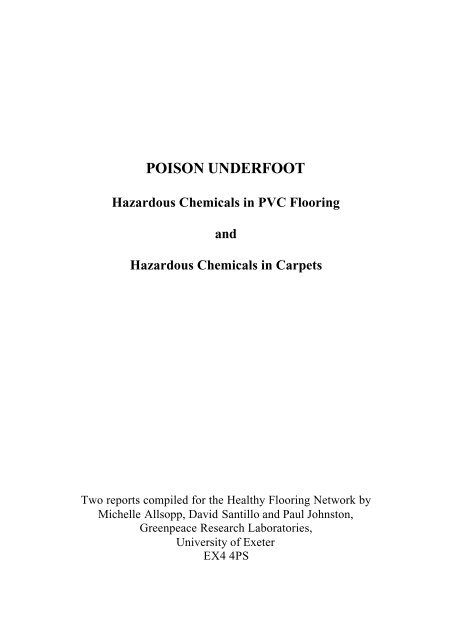
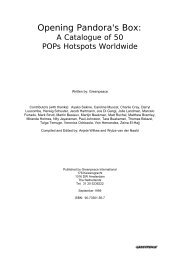
![3. Die Energie-[R]evolution](https://img.yumpu.com/22078498/1/184x260/3-die-energie-revolution.jpg?quality=85)
